July 31, 2011
Die Liebe der Danae, Bard Summerstage
Consequently, organizations such Bard Summerstage, which have these tenets incorporated into their mission, serve an invaluable purpose.
The opera portion of this year’s festival, saw the U.S. premier of Richard Strauss’s forgotten gem Die Liebe der Danae. At first glance, Bard’s decision to present this opera may seem a bit strange. After all, Strauss is a very well-represented late Romantic composer. Yet, on closer inspection, one realizes that Strauss, like Jean Sibelius, who co-shares the spotlight of this festival, fell out of favor with the 20th century public, who viewed his unabashed tonality as antique. To be sure, there are moments in Strauss’s music that are atonal, but as far as operas go, people were more interested in the shock value of Salome than in the lyricism of Die Liebe der Danae.
Despite occasional blemishes, the cast and production team managed to present the opera in such a way that made a compelling case for Strauss’s unapologetic melodies, as well as the composer’s penchant for utilizing even the most omnipresent of mythic gods.
Under the direction of Leon Botstein, the American Symphony Orchestra exhibited both the lyricism and the humor of the score. While it is wonderful to see a new side of a revered composer, it is also enjoyable to revel in what he is already known for. In this case, I would have liked to see more of a balance between the humor and lyricism in Act I, but Botstein improved in that regard as the opera progressed.
The cast was headed by Meagan Miller, who has previously won the National Council Auditions of the Metropolitan Opera. Her voice was powerful, yet also extremely lyrical. For those used to other sopranos such as Lauren Flanigan, the deep timbre of her voice may, at first, be disconcerting, but there were times throughout the performance, when during a lyrical passage, the audience was simply spellbound. As Midas, Roger Honeywell was stunning. Especially noteworthy was his Act I entrance, which put the difficulty of the role on par with Verdi’s Otello. There were times when he seemed to lose stamina, but those moments were few, and he quickly recovered. Of mention were Jud Perry, who played Mercury, and Aurora Sein Perry, Camille Zamora, Jamie Van Eyck, and Rebecca Ringle, who played Semele, Europa, Alcmene, and Leda, respectively. They brought a comic element to the opera which was much appreciated. Although the four women required time to warm up as an ensemble, they managed to create spotless psychological portrayals on the individual level, and by the end, they worked as a cohesive group.
It must be said that, as Jupiter, Carsten Wittmoser was a bit lackluster. However, he too improved by the last act. Still, it has been said that Jupiter was a complex character, on par with Der Rosenkavalier’s Maria Theresa, and Wittmoser missed many opportunities to demonstrate the complexities of this most-human king of the gods.
Overall the production was impeccable and visually compelling. The chorus sang strongly and portrayed the greedy inhabitants of Eos in a way that strengthened Kevin Newbury’s modern adaptation, which set the story in post-recession America. The physical aspects of the production were stirring. The stage pictures Newbury created demonstrated both the appeal and severity of wealth, a point so crucial to the story. Additionally, there were moments that were both comic, yet touching. Such was the case when, in Act III, Danae put her suitcases in the beat up jalopy that would her car in the decidedly unwealthy life she chose with her beloved Midas.
Bard Summerstage deserves credit for a job well done for successfully resurrecting an incredibly powerful 20th century work. Die Liebe der Danae is proof positive. While Strauss’s music may be lyrical, it is richly enduring. Tastes may change, but the humanity of Strauss’s music doesn’t.
Gregory Moomjy
image=http://www.operatoday.com/DanaeJanGossaert.gif image_description=Danae by Jan Mabuse (aka Jan Gossaert) product=yes product_title=Richard Strauss: Die Liebe der Danae product_by=Danae: Meagan Miller; Jupiter: Carsten Wittmoser; Midas: Roger Honeywell; Xanthe: Sarah Jane McMahon; Pollux: Dennis Petersen; Merkur: Jud Perry; Semele: Aurora Sein Perry; Europa: Camille Zamora; Alcmene: Jamie Van Eyck; Leda: Rebecca Ringle. American Symphony Orchestra. Conducted by Leon Botstein, music director. Directed by Kevin Newbury. Set Design by Rafael Viñoly and Mimi Lien. Costumes by Jessica Jahn. Lighting by D. M. Wood. product_id=Above: Danae by Jan Mabuse (aka Jan Gossaert)Rodelinda Triumphs at Iford Opera
Nobility in love and war — ideas fully understood in all of their ramifications in the season of 1724-25 when Handel wrote this marvellous music to match the libretto of Nicola Haym — are the cornerstones of this opera’s appeal and a wise director understands this. This time in Handel’s career — around his 40th birthday — was one of the most fertile in his life. Within just 14 months he had composed not only Rodelinda, but also Giulio Cesare and Tamerlano. All are great operas, and it’s no surprise to see all three regularly performed by the top opera houses around the world today. So, with a huge emotional canvas to explore with Rodelinda, how did the small but ambitious Iford Opera fare with this tale set in about 500 AD, in what is now northern Italy?
Brilliantly is the answer. At Iford’s Friday night first performance the full house of some 90 people were treated to what must be one of the most riveting and persuasive productions of this opera in the UK in the last decade - and all the more remarkable given the comparative youthfulness of the singers and constraints of this miniature faux-Italiante cloister performance space. And for once it was the whole artistic team working together to bring Handel’s great music to life: design, direction, music and voice. The opera, as is usual at Iford, is sung in English, and the young singers all had excellent diction — far better in fact than many of their more illustrious seniors working today.
The plot is (for opera seria) fairly straightforward: Rodelinda is Queen of Lombardy, her husband Bertarido is a king apparently defeated and killed by the usurper Grimoaldo who, not content with just the kingdom, also wants Rodelinda’s love as well. The Queen resists his blandishments, and of course pretty soon Bertarido does return and sets in motion the power-play between Good and Evil. Or at least, so it seems. There is more to this story than that of course and, gradually, through a series of passionate and soul-searching arias from all the protagonists we come to understand better the dilemmas of royal blood (or just power) and those who aspire to it.
Director Martin Constantine and designer Mark Friend have worked wonders with Christian Curnyn’s Early Opera Company to make the most of Iford’s “in the square” performance space and the usefully compressed and claustrophobic nature of this opera’s plot, based as it is inside the royal palace throughout, was ideal for their purposes. The focus of all the action is an all-purpose central table in, on, and around which everything revolves. Props are confined to clever use of paper : as screens, drapes, photocopied prints of family life before the troubles, and the odd knife here and there. Costumes were drab modern, with little to differentiate master from servant. As the EOC’s stylish period band of 13 musicians began the Overture the audience were bemused by large paper screens apparently blocking their view of the “stage” area but as the music came to an end hooded and cloaked men silently entered from different directions and dramatically tore into the screens and destroyed them: the throne of Bertarido had been usurped, Grimoaldo was now in power with Rodelinda and her son Flavio at his mercy, and let the action commence.
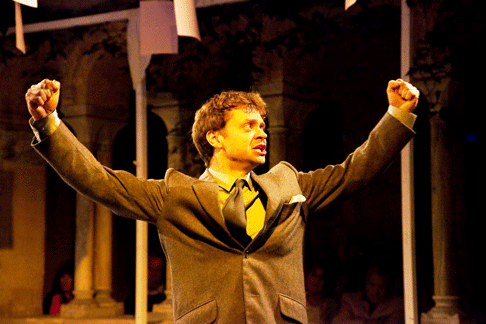 Owen Willetts as Unulfo
Owen Willetts as Unulfo
Here, from the very first notes of Rodelinda’s lament for her lost husband, it is immediately obvious that soprano Gillian Ramm is the real deal as a Handelian heroine. Her voice is warm, well-projected and secure of technique with a sumptuous gleaming top that she uses with musicality and confidence. As the evening progressed she showed some lovely colours in the slow airs and nicely appropriate ornamentation — her “Return, my dearest love” was intelligently phrased and limpidly sung, although a little more light and shade in dynamics could have improved the overall effect even more.
She was quickly joined by tenor Nathan Vale as the usurper Grimoaldo and baritone Jonathan Brown as his treacherous, ambitious henchman Garibaldo. Vale is well known in UK Handelian circles — a previous winner of the Handel Singing Prize in London — and his voice and acting have both developed well since then. His tenor is now best described as a strong lyric -although in this role only the delightfully lilting “Happy shepherd boy” near the end of the final Act allows him to show his more lyrical qualities. His obvious command of Handelian idiom coupled well with some detailed acting of this complex character who is torn between right and wrong throughout; some initial tightness at the top of his range soon disappeared and he gave a memorable performance.
He was matched both vocally and dramatically by Brown as the scheming Garibaldo — this part is so easily reduced to cardboard-cutout villainy that it was a revelation to see and hear Brown discovering the nuances of Handel’s scoring for this unpleasant character. His baritone is not of the chocolate-smooth variety but it is flexible, expressive and commanding without resorting to the baritone “bark” one sometimes hears. A very polished performance.
As Rodelinda’s husband and king of Lombardy, Bertarido is the typical Handelian hero in all his complexity. Sung here by the rising British countertenor James Laing, we were treated to some sensitive and perceptive music-making which brought the character’s emotional journey very close to home — his duet with Ramm in “I embrace you” was a highlight for them both. As Bertarido descends into depression and despair towards the end of the first half his singing was simply heart-rending and his acting totally committed. Laing’s voice is sweet, supple, light and flexible but not large; having heard him sing Vivaldi at Garsington recently I was surprised to find him a little lacking in projection here. He was tiring by the end after an all-guns-blazing “Live tyrant” and perhaps was not one hundred per cent fit on this night.
The other male “good guy” of the opera is Bertarido’s servant/assistant Unulfo who epitomises the ideals of loyalty, strength of character, courage beyond the call etc. He is not an out and out hero: he is the little guy, the ignored chap in the corner, the one who sees everything and says little. As such, it’s a gift for any singing actor and although shorn of two arias early in the opera in this production, young Owen Willetts made the most of it and in doing so displayed an astonishing countertenor voice that lingers in the memory. His voice is dark, dark, and darker with a power and projection that reminded me of early Derek Lee Ragin or perhaps Bejun Mehta, which is all the more surprising given his English choral scholar background. His expressive features and obvious facility for dramatic expression when intelligently directed complete the picture, and if he lacks heroic inches there’s plenty else to compensate.
The final character completing this intense cauldron of power and passion is that of the wronged, vengeful Eduige, sister of Bertarido and focus of Garibaldo’s ambition and lust. Irish mezzo soprano Doreen Curran is an accomplished actress and threw herself into this role with a full, flexible mezzo which she used with dramatic flair. The voice is rich and warm in the middle with some golden tones at the top and her scenes with Brown were thrillingly intense, although perhaps there was scope for more ornamentation in her da capos, particularly in her early “vendetta” aria. Again, as with all these singers, her diction was superb.
A word must be said about the mute role of the boy Flavio, played on first night by the very young actor Yves Morris. He stayed in character throughout his scenes (which were long and intense) and gave a very promising performance, whatever his future holds.
Curnyn’s Early Opera orchestra is now one of the best small period bands around and their contribution to the production cannot be underestimated; driving, supporting and colouring the drama at every turn with some skilled and responsive playing. Some minor tuning problems in the strings half way through were quickly sorted and the thirteen players received their fair share of what was a prolonged and very enthusiastic ovation for this terrific Rodelinda. Handel opera is so often these days second-guessed by ego-driven directors and stage producers; Iford Arts can be congratulated on producing a modern version that stayed true to the essence of England’s greatest composer.
Sue Loder
Handel’s Rodelinda continues at Iford Opera, Bradford on Avon, England on August 2nd, 3rd, 5th 6th and 9th. A few tickets remain at time of writing. See www.ifordarts.co.uk
image=http://www.operatoday.com/Rodelinda_Iford_01.gif image_description=Gillian Ramm as Rodelinda and James Laing as Bertarido [Photo courtesy of Iford Arts] product=yes product_title=G. F. Handel: Rodelinda product_by=Rodelinda: Gillian Ramm; Bertarido: James Laing; Grimoaldo: Nathan Vale; Garibaldo: Jonathan Brown; Eduige: Doreen Curran; Unulfo: Owen Willetts; Flavio: Alex Surtees/Yves Morris. Director: Martin Constantine. Designer: Mark Friend. Conductor: Christian Curnyn. Music: Orchestra of the Early Opera Company. product_id=Above: Gillian Ramm as Rodelinda and James Laing as BertaridoPhotos courtesy of Iford Arts
July 29, 2011
Rigoletto, Opera Holland Park
Tom Scutt’s clever set is economical and theatrically effective. Two rusty, corrugated iron freight units, helpfully labelled ‘Italia’ in case we are in any doubt of the location, may not immediately be visually appealing; but, spun and disrobed to reveal first a bordello bondage cage à la Berlusconi, then Rigoletto’s meek abode, next Sparafucile’s seedy bar which is itself transformed into the assassin’s gruesome abattoir, they prove efficient and engaging.
They also neatly contain the various locations but also allow for some pointed juxtapositions between interiors and exteriors, thereby enhancing tragic ironies. Thus, as Gilda promises her father that her love was only for him and for God, we see the Duke persuading Giovanna to allow him admittance to the young innocent’s sparse bedroom, foreshadowing the subsequent seduction. Similarly, we witness the plotting of Gilda’s abductors as she sleeps unknowingly within. Moreover, Gilda’s own ascent to the roof-top, effectively indicates her desire for freedom from her father’s jealous, selfish oppression. Most powerfully, in the Act 3 quartet, Gilda and Rigoletto cower in the gloom without, overhearing the Duke’s flirtations with Maddalena within — the contrasting sentiments which animate the four characters convincingly revealed and fully intelligible.
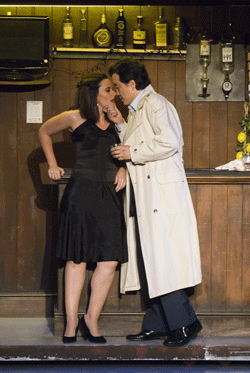 Jaewoo Kim as Duke and Patricia Orr as Maddalena
Jaewoo Kim as Duke and Patricia Orr as Maddalena
Director Lindsay Posner has updated the action to an unspecified modern era — Jonathan Miller’s Mafioso motifs, all sinister dark glasses and slick suits, retain their influence. But, despite the success of Miller’s seminal production, there remain some problems with such an updating. The opening ball scene may be suitably colourful — red velvet-clad hussies slinkily gyrating and twisting between the black-masked tuxedoes, and the piquant dances and carefree gaiety ticking the debauchery box — but the overall impression is not really the ‘kingdom of pleasure’ of which the revellers boast.
And, bunga-bunga parties don’t generally employ a ‘court jester’. Thus Rigoletto’s appearance, clutching a cane walking stick, afflicted by a small hunch, and sporting a ‘buffone’ ti-shirt seems a little out of kilter.
Similarly, it’s customarily necessary for the audience to imagine Gilda as much younger than the average prima donna in the role: but here, it is hard to believe that the tomboy-ish naïf in hoodie and leggings knows nothing at all of life or love, or even her father’s name. Moreover, for one so innocent, Gilda’s maidenly resistance gives way with remarkable rapidly under the pressure of the Duke’s passionate wiles. Surely the florid coloratura of one so pure should not be accompanied by sexual shivering and writhing among the tousled sheets?
Bewitched by her aristocratic wooer, Gilda delivers ‘Caro nome’ clutching a pillow in a dancing embrace, while her hairbrush is fashioned into a wannabe’s microphone — all that is missing is some air-guitar strumming and strutting; not bad for a girl who leaves the house only to go to church, and who — judging by the paucity of her decrepit surroundings (certainly her home is humble, but is it really a hovel?) - is not in possession of even a transistor radio.
Perhaps such criticisms are unfair, for elsewhere, Posner demonstrates a notable attention to detail, resulting in an imaginative reinterpretation of familiar moments. Thus, we witness Gilda’s suicidal lunging for Sparafucile’s knife intent, despite her beloved’s infidelities, on self-sacrifice to save the Duke. And, the bar-TV screen, showing Seria A is interrupted by Pavarotti’s rendering of ‘La donna è mobile’, itself swiftly silenced by some speedy zapping by the Duke, neatly timed to coincide with the score.
And, there is much fine singing. As the Mantuan Duke, Korean-born Australian tenor Jaewoo Kim is perhaps somewhat miscast. Solid and reliable, he never looked completely comfortable as the smarmy charmer, or sufficiently predatory as the celebrant of promiscuity in ‘Questa o quella’. A rather tentative host in the opening party scene, the Duke’s dishevelled appearance in boxer shorts after his assignation with Maddelena hardly presents him as a louche libertine. Though accurate and secure of intonation, Kim lacks a true lyric quality and the requisite warm palette of colours, and his voice was somewhat hard and inflexible, particularly at top. Without sufficient musical and theatrical presence to command the stage, the Duke was at times unfortunately overshadowed, as in his agitated Act 2 aria when he laments the loss of the girl who has become the lodestar of his life — never convincing sentiments at the best of times.
Verdi’s jester is not a benign joker, rather a bitter, cruel man who, warped by his physical deformity, is selfish and abusive. But he is also a portrait of psychological and physical suffering and thus his physical deformities must be made clear if he is to be more than a mischievous imp, and if his paranoia and resulting spiteful vindictiveness are to be understood and forgiven. In his donkey jacket and Viking helmet, Robert Poulton’s scarcely inhibited ‘hunchback’ has to work hard to win our sympathy. But, Poulton proves himself eminently able to deal with the vocal demands and stamina of this challenging role; particularly impressive were the long recitatives, such as that which follows his first encounter with Sparafucile. His vengeful anger and bitterness were always clear, and he worked hard to arouse our sympathy in the duets with Gilda, producing a pleasing cantabile in ‘Piangi, fanciulla’.
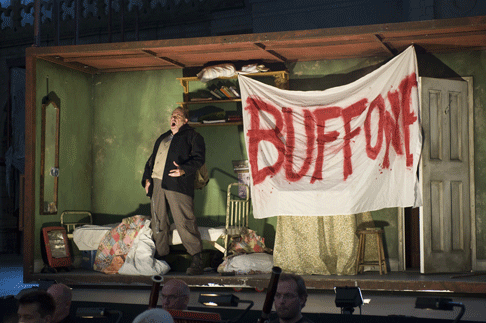 Robert Poulton as Rigoletto
Robert Poulton as Rigoletto
Julia Sporsén, as Gilda, was a real revelation, displaying superb clarity and projection, her tone pure and effortlessly pleasing; she revelled in the bright coloratura and the simple childlike lyricism with equal aplomb — although, as ever, it proved difficult to reconcile the showy bravura with trusting simplicity. Sporsén may have lacked a genuine pianissimo but she demonstrated true tenderness in the opera’s final moments, and more than compensated for a lack of dynamic range with a soaring, gilded soprano as she appealed to Heaven for pity. Posner’s ‘masterstroke’ was saved for this final duet: for, instead of a momentary miracle recovery in father’s arms, summoning just enough strength to tell her heart-broken, frenzied father how she deceived him, this Gilda has already joined her mother in Heaven - an angelic voice, aloft, real or imagined, while the hunchback, clutching a body-bag, laments his misguided love and irredeemable loss. For once, no suspension of disbelief was required, and the distance both literal and metaphorical between father and daughter was touchingly rendered.
Graeme Broadbent’s Sparafucile radiated stentorian menace; his cavernous bass conveyed the emotionless amorality of the aproned butcher, who sharpened his knives like a demon barber. As Monterone, William Robert Allenby struck a dignified figure, his brooding, powerful bass-baritone suitably aggrieved.
In the other minor roles, a leather-clad Patricia Orr was a lively Maddalena, while Laura Wood’s Giovanna smuggled the Duke under Gilda’s dressing table with perfect timing. The chorus sung with secure ensemble.
Conductor Stuart Stratford was consistently alert to the musical details, coaxing beautiful solo playing from his principal cello, clarinet and oboe. After a solemn opening (perhaps the horns might have provided a touch more menace), he skilfully controlled the subtle shifts of pace, volleying rhythmic rises, and swelling instrumental furies followed by anxious descents, which characterise Verdi’s melodramatic score.
The venue itself provided the icing on the cake, as the darkening sky cast natural shadows heralding the approach of the louring storm and soughing wind, and signalled the unavoidable fulfilment of Monterone’s curse.
Overall, OHP served up a truly enjoyable evening of much fine musicianship and, despite a few false notes, some genuinely fresh theatrical insights.
Claire Seymour
image=http://www.operatoday.com/Rigo-207-1.gif image_description=Robert Poulton as Rigoletto and Julia Sporsén as Gilda. [Photo by Fritz Curzon.courtesy of Opera Holland Park] product=yes product_title=Verdi: Rigoletto product_by=Rigoletto: Robert Poulton; Gilda: Julia Sporsén; Duke : Jaewoo Kim; Sparafucile: Graeme Broadbent; Maddalena: Patricia Orr; Count Ceprano: Simon Wilding; Monterone: William Robert Allenby; Marullo: John Lofthouse; Borsa: Neal Cooper; Countess Ceprano: Anna Patalong; Giovanna: Laura Woods; Court Usher: Mark Spyropoulos; Page: Nicola Wydenbach; Conductor: Stuart Stratford; Director : Lindsay Posner. Designer: Tom Scutt. Lighting Designer: Philip Gladwell. Choreographer: Nikki Woollaston. Opera Holland Park, Tuesday, 26th July 2011. product_id=Above: Robert Poulton as Rigoletto and Julia Sporsén as GildaAll photos by Fritz Curzon.courtesy of Opera Holland Park
July 28, 2011
Boston Midsummer Opera’s Italian Girl in Algiers
Undertaken in response to a desperate plea from the Teatro San Benedetto in Venice to fill a gap in the spring schedule, Rossini’s opera was completed in an astonishing twenty-seven days. It was the work of a young man — it could be argued that all of Rossini’s operas are the works of a young man, since he retired from the theater at thirty-eight — but by no means an inexperienced one: La scala di seta, La pietra del paragone, and Tancredi were already behind him. The impress of Mozart’s most ebullient moments is still heavy on the very young Rossini, but this is a kind of Mozart in constant and barely controlled agitation: not for Rossini the long lyrical lines of his friend in later life, Vincenzo Bellini. The libretto, which had already been set by Luigi Mosca just a few years earlier, is a farcical continuation of the European fascination with Turkish, and more broadly Middle Eastern, themes and ideas: the dauntless Isabella, fortuitously shipwrecked in Algiers, chances upon her lost lover, now enslaved, and contrives to free herself and him, while making a fool of the Bey Mustafa.
Director Minter and designer Dobay have resituated the piece in the present day, in a place more or less like the U.A. E. (so much for Algiers!), which has made an uneasy compromise with Western culture — the Bey and his wives in more or less traditionally Arab garb, while the Bey’s henchmen wear shirts and trousers. The dazzling single set suggested the jewel-toned interiors of a palace, with easy access to a stylized dock, while cinnamon-colored silhouettes suggested the towers of the city beyond and around the action; it made the best of the stage, urging the cast forward toward the audience. It seems to have been, if one reads the notes, the intention of both the music director and the stage director to bring an undercurrent of real danger to the proceedings (Barbary pirates! Sexism!), but happily this ambition had faded out within half an hour. For all that we know about Rossini’s flexibility in supplying new arias for new cities or singers, his dramaturgy at its best proceeds with ironclad determination: Rossini’s unstoppable music and the dramatic flow it illustrates tell us insistently that this is a farce, not a melodrama. There is no way to confuse Italiana with The Death of Klinghoffer. Mustafa is not menacing: he’s infantile; he’s been declawed by the end of the first act.
As the richly characterized Isabella, the fourth of the flexible roles for the low-meezo voice Rossini cherished (but not the last: Rosina and Angelina were to follow) Eddy sang with notable accuracy, and her remarkable beauty was underscored by her comic flair. Downs must be one of the younger and better-looking Mustafas on record. There was a certain active tone in his voice which, while a benefit to lyrical singing, slightly blurred some of his passage-work. As the hapless Lindoro, Williams sang well, very much in the manner of the Irish tenor, with that high and forward placement. Kravitz’s Taddeo was an agreeable goof, while Jakubiak, in the rather thankless role of the rejected wife, acquitted herself well, despite passing pitch inaccuracies in the first act. BMO reduced Rossini’s male double-chorus to four voices — the Bey’s muscle — which made sense dramaturgically, but effectively reduced the piece to a chamber opera. Wyner’s orchestra played with a clean accuracy, although the singers were occasionally tempted to get ahead of her.
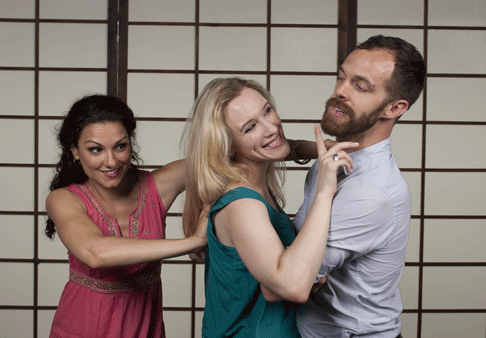 (L-R) Sandra Piques Eddy as Isabella, Sara Jakubiak as Elvira, and Eric Downs as Mustafa
(L-R) Sandra Piques Eddy as Isabella, Sara Jakubiak as Elvira, and Eric Downs as Mustafa
One of the challenges of Angelo Anelli’s quite serviceable libretto is the nature of Isabella’s relationship with the men in her life. Who is Taddeo (Kravitz) — cast-off lover? Failed suitor? Is he an old man, a pantalone, or just a luckless young or middle-aged one? One has the notion that Anelli never quite decided, and the age-old uncertainty hovers over this production as it does over most. How can Lindoro (Williams), passive in his captivity while awaiting his Isabella, seem more than effete? It is remarkably difficult to bring Lindoro into focus, and almost impossible, dramaturgically, to bring them into focus together. The comedy is almost reducible to a contest of wills between the spirited Isabella and the schoolyard-bully Mustafa. As the conductor’s notes rightly point out, it is a specimen also of the then-popular “rescue” opera. She fails to mention, however, its striking resemblance to the greatest “rescue” opera, which similarly features a surprising female rescuer: Fidelio, the first version of which predated Italiana by eight years, and the final version of which followed it by only a year. These operas, like the contemporary writings of Madame de Stael and Mary Wollstonecraft, ask: what is the capacity of a woman? In Rossini’s works, the woman steadily loses power, until she is a sinner (Semiramide), and then hardly more than a cipher (Comte Ory; Guillaume Tell).
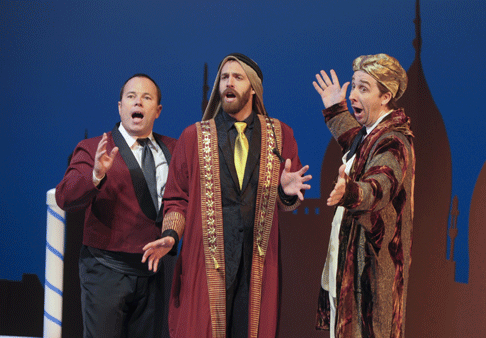 (L-R) Bradley Williams as Lindoro, Eric Downs as Mustafa, and David Kravitz as Taddeo
(L-R) Bradley Williams as Lindoro, Eric Downs as Mustafa, and David Kravitz as Taddeo
We have little trouble now in agreeing with the very young Rossini on the joys of seeing a woman exert all the force of her beauty and wit — but what of the mode alla Turca? Minter’s version, which connects the dots between the Turkish threat circa 1800 and today’s oil magnates with shady “shipping” practices, hardly diminishes the cultural chauvinism of the original, and concludes in the same place. It is just more fun, according to Anelli and Rossini, to be Italian than anything else, and Isabella and her friends want nothing better than to be back home, where women are free; Minter’s production, which concludes with the Bey’s thugs converted to pseudo-Italian clothing (to the point of waving little Italian flags), ready to expatriate, and the Bey himself, as well as his wife, in semi-Western garb, tacitly agrees with them, cultural anxiety notwithstanding. Still, Boston Midsummer Opera delivers a Rossini production of great verve and clarity — a real summer pleasure.
Graham Christian
image=http://www.operatoday.com/IGIA-2.gif image_description=Sandra Piques Eddy is Isabella [Photo by Chris McKenzie courtesy of Boston Midsummer Opera] product=yes product_title=Gioacchino Rossini: The Italian Girl in Algiers (L’Italiana in Algeri) product_by=Isabella: Sandra Piques Eddy; Lindoro: Bradley Williams; Taddeo: David Kravitz; Mustafa: Eric Downs; Elvira: Sara Jakubiak; Zulman: Julia Mintzer; Ali: David Lara. Vocal Quartet/Chorus: Sean Lair, Michael Kuhn, Stephen Humeston, Joshua Taylor. Music Director and Conductor: Susan Davenny Wyner; Stage Director: Drew Minter; Scenic Designer: Stephen Dobay. Tsai Performance Center, Boston, 27, 29, 31 July 2011. product_id=Above: Sandra Piques Eddy as IsabellaAll photos by Chris McKenzie courtesy of Boston Midsummer Opera
July 27, 2011
Rigoletto, Miami Lyric Opera
Wanton rankling may start off with high ratings and a spike in tickets sales but can easily degenerate into opprobrium and murk an artistic work’s essence. The opera Verdi and Piave set out to complete for Teatro La Fenice was on course for such an ignoble providence were it not for the duo’s imagination, and discretion. La maledizione was the working title for the opera almost cursed with the sort of attention that would dull its artistic merits.
Distilled from a Victor Hugo play with a checkered performance past, the opera would meet with its own curses before its premiere in 1851. The play (Le roi s’amuse) and the opera (Rigoletto) revolve around such a curse, something Miami Lyric Opera Director Raffaele Cardone reminded of when he addressed the audience pre-performance on opening night June 23rd. Placing the context of Rigoletto directly on, and finding its dramatic pole in, the curse teased the imagination as to what was to come, holding out the suspense of the grist for Rigoletto’s mill: La maledizione.
This performance marks a whole new set of standards for MLO. Sets (designed by Carlos Arditti), still on the main backdrops, were more suggestive of the piece (in this case, 16th century Mantova) and redolent of specific scenes: there were columns and archways at the party and a nicely lit (in blue) background, the alley where the sanction was dealt was as an hallucination - a dark and muggy picture; Rigoletto’s domicile was depicted by a patently different scene (turning a bit cheeky when a flimsy wall shook terribly as the jester set the ladder on it). The curtain rose for the final time to a tavern that any assassin might find a suitable safe house.
Artistic expression and sensibility in staging too have improved for the small company. A soft screen hazed the view of the opening scene, the ballroom at the Ducal palace; courtiers held their dance poses for the length of the overture. Movement in the room thereafter was well-planned, with varied exchanges as members of the court came in contact with each other. Blocking and shifting of positions was thoughtful too for the Act Three gathering of Gilda’s abductors. Adequate effects (strobes/lighting by Kevin Roman) in that final scene at the tavern saw to a turbulent tempest.
Musically, including in the singing, those heading the company have much to be pleased with. Conductor Doris Lang Kosloff and players seemed to work well together, resulting in nice string articulation (with fine violins in Cortigliani), sweet flute phrasing (in the work’s echoed themes) and well-modulated dynamics. Miguel A. Raymat beat clear, accurate, and powerful sounds on the kettle drum, supporting the overture, the storm, and the finale.
Cuban baritone Nelson Martinez first appeared with MLO in a Gala concert in the spring of 2007; Martinez sang a Rigoletto later that same season. With the company he as appeared as Rossini’s Figaro, Escamillo, and Giorgio Germont. Locally, Martinez is considered a tested talent; his proved to be the most schooled voice — technically and stylistically — in this cast. As far as size (and heartiness) and the ease of its use in high tessitura, Martinez’s voice does well by Verdi. It is hard to forget the force of the high note he held out to close ‘Pari siamo’.
MLO went out of town for the Gilda. Gina Galati is an American soprano that has studied in a Verdian Academy at Bussetto; she has the voice — its flutter fitting for ‘Caro nome’ — and looks of a soubrette. This was Galati’s first singing engagement with MLO; she shared Gilda with local Susana Diaz (the Gilda on June 25th). As the cad, the vehicle through which Verdi’s opera gets interesting, the Duke of Mantua, Aurelio Dominguez had some laudable moments in this tricky role and his first outing with MLO (two other tenors sang on subsequent performance evenings). The difficult recitative and aria that opens Act Two, where the Duke implores the heavens over the snatching of Gilda, was a triumph for the tenor. Dominguez ducked few obstacles, meeting Galati for the high note in their duet.
MLO returnee Diego Baner made a fine Sparafucile vocally — the rapid vibrato of his bass an interesting change of pace. On the stage, Baner distracted with his tendency to look downward. Graduating from the Florida Grand Opera chorus to a critical role here, Monterone, Cuban bass-baritone Armando Naranjo clearly understands the importance of the curse; Naranjo communicated anger with constant fervor in his singing. Lisseth Jimenez was a saucy Maddalena of darkish tone and Jesse Vargas and Mathew Caines did good work in their brief moments as Borsa and Marullo. Ketty Delgado (Giovanna) and Erica Williams (Paggio) appeared for the first time with MLO.
Pablo Hernandez (Chorus Master) did not put his group to work for the storm and the singers were musically rough here and there (in the second act, the men were at odds over entrances and the text). In the case of costumes, Pamela De Vercelly is credited for colorful work. Vercelly will not be faulted for hosiery (a few with Swiss cheesy wear) unflattering to male cast members whose best features are not their legs. One could be cursed with much worse.
La maledizione would also be a dummy title meant to throw authorities off the scent of Verdi and Piave and their busy redactions of Hugo’s Le roi s’amuse. Hugo encountered trouble mounting the play in France due to its content and the opera was meeting with similar obstructions in Italy some twenty years later. As it went, La maledizione went through a number of textual alterations as Verdi and Piave tried to satisfy censors that feared the reprisal of royals over their less than stately depiction. La maledizione wound up retaining its place in the story; the hunchback also remained and was renamed, as was the opera, Rigoletto.
Robert Carreras
image=http://www.operatoday.com/RigolettoMLOMartinezGalati.gif image_description=Nelson Martinez as Rigoletto and Gina Galati as Gilda [Photo courtesy of Miami Lyric Opera] product=yes product_title=Giuseppe Verdi: Rigoletto product_by=Rigoletto: Nelson Martinez; Gilda: Gina Galati/Susana Diaz; Duke of Mantua: Aurelio Dominguez/Eduardo Calcano/Luis Riopedre; Sparafucile Diego Baner; Maddalena: Lissette Gimenez; Monterone: Armando Naranjo/Ismael Gonzalez; Borsa: Jesse Vargas; Marullo: Matthew Caines; Giovanna: Ketty Delgado; Ceprano: Ismael Gonzalez/Armando Naranjo; Contessa: Daisy Su; Paggio: Erica Williams; Usciere: Eric Dobkin/Jesus Gonzalez. Conductor: Doris Lang Kosloff. Chorus Master Pablo Hernandez. Costumes: Pamela De Vercelly. Stage: Val Medina. Lighting: Kevin Roman. Sets: Carlos Arditti. product_id=Above: Nelson Martinez as Rigoletto and Gina Galati as Gilda [Photo courtesy of Miami Lyric Opera]July 26, 2011
Verdi’s Requiem, BBC Proms
But following this sacred premiere, the work went on to have 3 further performances at La Scala and Verdi then took it on tour round theatrical venues in Europe. So from the word go, the piece has been poised between the sacred and the secular. It is this which gives the piece some of its fascination and difficulty. Verdi’s writing mixes operatic elements with some which are more sacred. For soloists he calls for 4 experienced Verdians, but then he writes unaccompanied ensemble passages for them which are some way from what he would have written in an opera.
At the BBC Proms on Sunday 24th July, Semyon Bychkov conducted BBC forces in a very large scale performance. There were 3 choirs (BBC Symphony Chorus, BBC National Chorus of Wales and the London Philharmonic Choir) with the BBC Symphony Orchestra and a quartet of soloists all with strong Verdian credentials (Marina Poplavskaya, Mariana Pentcheva, Joseph Calleja and Ferrucio Furlanetto). The three choirs numbered around 450 singers and the orchestra was similarly large scale, complete with a cimbasso on the brass bass line (instead of the modern tuba or euphonium)
This issue of size is an interesting one, which can also be traced back to Verdi’s original performances. Though the 1874 performances at La Scala used a choir of 120, when Verdi took the work on tour round Europe his attitude seems to have been flexible. So that whilst he performed the piece in Paris at the Opéra-Comique (not a large theatre), in London it was performed at the Royal Albert Hall in 1875 with huge forces. Clearly Verdi was not dogmatic about the forces involved, so we should not be either. Instead we can sit back and revel in the sheer sound that Bychkov conjured from his Proms forces.
The opening demonstrated what a wonderful sound can be created by a disciplined large choir singing in hushed tones. Though big in scale, this wasn’t a driven or a bombastic performance, Bychkov drew some beautifully quiet and detailed singing from his choristers. The difficulty of combining 450 singers in such a space should not be underestimated and it is to the three choirs’ credit that their choristers combined in such a powerful and disciplined fashion.
All was not quiet, of course. Come the ‘Dies Irae’ then all hell was let loose in appropriate fashion. Here we were able to take stock of Bychkov’s flexible tempi. He did not drive the piece forward manically, but let it expand at a rate suitable for the Albert Hall’s problematic acoustic. The ‘Dies Irae’ was not the fastest performance that I have experienced, but even when letting the music breathe Bychkov kept up the power and momentum in an impressive fashion.
The chorus’s big solo moment, of course, comes in the ‘Sanctus’ where they perform without the soloists. Here we got some beautifully detailed singing, and fine dancing tone.
The soloists were an interesting bunch, each with a distinctive and particular voice. Mezzo-soprano Pentcheva was a last-minute replacement for Sonia Ganassi. Pentcheva has proven Verdi credentials; her voice combines a distinctive dark hued lower register with a flexible upper, capable of some lovely quiet singing. She has a strong vibrato which might not be to everyone’s taste. She proved tasteful and flexible in her singing and brought some great beauty to her quiet moments, along with vivid projection of words.
Calleja sang the tenor part with full tone and a fine sense of line; he brought a fine sense of quiet rapture to the ‘Hostias’. Perhaps he missed the more bravura elements of the part, but he was a fine ensemble singer contributing intelligently to the many concerted solo moments. Ferrucio Furlanetto brought a world-weary grandeur to the bass part; lacking the ultimate in power, he showed commitment and discipline along with a fine sense of line.
Finally, of course, we come to the soprano; whilst all the soloists have their moments, Verdi’s use of the soprano in the final ‘Libera me’ ensures that it is the soprano who we remember best. Poplavskaya brought her familiar plangent tones and beautifully expressive line to the role, singing with a commitment which suggested she was living the part rather than just singing a soprano solo. She floated some supremely lovely lines during the piece, but these were always intelligently placed and not just vocalism for its own sake. In the ‘Libera me’ she took the drama to the point where she was in danger of becoming manner, but the ‘Requiem’ section where she sang just accompanied by the unaccompanied choir was simply beautiful. Though I must admit to having a slight reservation, Poplavskaya’s quiet plangency threatened to push the notes below pitch, but this was a small point in what was a very fine performance.
The soloists are more than just 4 individuals, Verdi asks them to sing in ensemble rather a lot and to do so unaccompanied. Poplavskaya, Pentcheva, Calleja and Furlanetto patently listened to each other and though their voices were very different, created a real ensemble. Most people who have heard the Requiem quite a few times have stories about the intonation problems in these ensemble passages. But not here. And in the ‘Agnus Dei ‘Poplavskaya and Pentcheva sang in octaves in a way which, whilst not quite of one voice, came pretty close.
The BBC Symphony Orchestra provided sterling support and some brilliant playing. Granted their string tone does not approach the vibrancy of the best bands in this music, but they brought commitment, intelligence and delicacy.
Bychkov controlled all in a way which allowed the detail of the work to be felt without compromising the big moments. This was certainly a performance of contrasts. Inevitably some detail gets lost in the Albert Hall, but Bychkov brought out much that was finely wrought, then contrasted it with some spectacularly loud moments. The ‘Dies Irae’ and the ‘Tuba Mirum’ are not the be all and end all of a performance of Verdi’s Requiem; here these big moments were big indeed but contrasted with some moments of nicely quiet intensity.
Robert Hugill
image=http://www.operatoday.com/poplavskaya_marina.gif image_description=Marina Poplavskaya [Photo courtesy of Zemsky Green Artist Management] product=yes product_title=Giuseppe Verdi: Requiem product_by=Marina Poplavskaya, soprano; Mariana Pentcheva, mezzo-soprano; Joseph Calleja, tenor; Ferruccio Furlanetto, bass. BBC Symphony Chorus. BBC National Chorus of Wales. London Philharmonic Choir. BBC Symphony Orchestra. Semyon Bychkov, conductor. product_id=Above: Marina Poplavskaya [Photo courtesy of Zemsky Green Artist Management]July 25, 2011
Placido Domingo announces Operalia winners in Moscow
[LA Times, 25 July 2011]
The annual Operalia competition, held this year in Moscow, concluded Sunday with a ceremony led by the organization's founder, Plácido Domingo. The first-prize winners were American tenor René Barbera and South African soprano Pretty Yende.
July 22, 2011
G. F. Handel: Athalia
Music composed by G. F. Handel. Libretto by Samuel Humphreys, after Athalie by Jean Racine (1691).
First performance: Oxford 1733
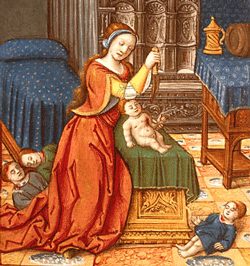 Athalia Killing the Royal Children [Source: sang sabda]
Athalia Killing the Royal Children [Source: sang sabda]
| Principal Performers: | |
| Athalia, Baalite Queen of Judah and Daughter of Jezebel | Soprano |
| Josabeth, Wife of Joad | Soprano |
| Joas, King of Judah | Boy Soprano |
| Joad, High Priest | Alto |
| Mathan, Priest of Baal, formerly a Jewish Priest | Tenor |
| Abner, Captain of the Jewish Forces | Bass |
From Second Kings 11 (KJV):
1And when Athaliah the mother of Ahaziah saw that her son was dead, she arose and destroyed all the seed royal. 2But Jehosheba, the daughter of king Joram, sister of Ahaziah, took Joash the son of Ahaziah, and stole him from among the king’s sons which were slain; and they hid him, even him and his nurse, in the bedchamber from Athaliah, so that he was not slain. 3And he was with her hid in the house of the LORD six years. And Athaliah did reign over the land.
4And the seventh year Jehoiada sent and fetched the rulers over hundreds, with the captains and the guard, and brought them to him into the house of the LORD, and made a covenant with them, and took an oath of them in the house of the LORD, and shewed them the king’s son. 5And he commanded them, saying, This is the thing that ye shall do; A third part of you that enter in on the sabbath shall even be keepers of the watch of the king’s house; 6And a third part shall be at the gate of Sur; and a third part at the gate behind the guard: so shall ye keep the watch of the house, that it be not broken down. 7And two parts of all you that go forth on the sabbath, even they shall keep the watch of the house of the LORD about the king. 8And ye shall compass the king round about, every man with his weapons in his hand: and he that cometh within the ranges, let him be slain: and be ye with the king as he goeth out and as he cometh in.
9And the captains over the hundreds did according to all things that Jehoiada the priest commanded: and they took every man his men that were to come in on the sabbath, with them that should go out on the sabbath, and came to Jehoiada the priest. 10And to the captains over hundreds did the priest give king David’s spears and shields, that were in the temple of the LORD. 11And the guard stood, every man with his weapons in his hand, round about the king, from the right corner of the temple to the left corner of the temple, along by the altar and the temple. 12And he brought forth the king’s son, and put the crown upon him, and gave him the testimony; and they made him king, and anointed him; and they clapped their hands, and said, God save the king.
13And when Athaliah heard the noise of the guard and of the people, she came to the people into the temple of the LORD. 14And when she looked, behold, the king stood by a pillar, as the manner was, and the princes and the trumpeters by the king, and all the people of the land rejoiced, and blew with trumpets: and Athaliah rent her clothes, and cried, Treason, Treason. 15But Jehoiada the priest commanded the captains of the hundreds, the officers of the host, and said unto them, Have her forth without the ranges: and him that followeth her kill with the sword. For the priest had said, Let her not be slain in the house of the LORD. 16And they laid hands on her; and she went by the way by the which the horses came into the king’s house: and there was she slain.
Click here for the complete libretto.
image=http://www.operatoday.com/Athalia_Dore.gif image_description=Death of Athaliah. Engraving by Gustave Doré (1832-1883) audio=yes first_audio_name=G. F. Handel: Athalia first_audio_link=http://www.sarastro.info/music/handel/athalia/Athalia_Koln.mp3 product=yes product_title=G. F. Handel: Athalia product_by=Athalia: Simone Kermes; Josabeth: Sarah Fox: Joas: Johannette Zomer: Joad: Iestyn Davies: Mathan: James Gilchrist; Abner: Neal Davies. Balthasar-Neumann-Chor. Concerto Köln. Director: Ivor Bolton. Live performance, 24 May 2009, Kölner Philharmonie. product_id=Above: Death of Athaliah. Engraving by Gustave Doré (1832-1883)Strauss Joins Sibelius’s Vacation
By Peter G. Davis [NY Times, 22 July 2011]
HOW, you may ask, does an opera by Richard Strauss find its way into a music festival devoted largely to the world of Jean Sibelius? This great Finnish composer is the focal point of this year’s SummerScape extravaganza now under way at Bard College in Annandale-on-Hudson, N.Y., and an important operatic novelty is invariably a highlight of the festival. But Sibelius never wrote an opera of any size or substance. To include one by Strauss — even a relative rarity like “Die Liebe der Danae,” which receives what is said to be its first fully staged performance in the New York region on Friday evening — seems a bit of a stretch.
The Sopranos — Dissecting opera’s fervent fans
Herr Engels and his wife were enjoying retirement with a cultural event every single night, whether that be opera or the symphony or theater or a gallery opening; tonight, he had set his sights on me and wanted my opinion. I had one — small and squalid and intense as it was — but while Herr Engels had been steeped in culture, I had merely dipped a toe in. I had seen my first opera for the first time less than a year before, and he was asking for me to report on what I had seen. I didn’t have the language for it yet, not even a basic vocabulary. I started to list the Berlin operas I had seen — Prokofiev’s The Love for Three Oranges, Braunfels’s Jeanne d’Arc, Wagner’s Rienzi…
“Ah, the Rienzi. How was that?”
I mistakenly believed that he was asking because he had not seen that production. I started to explain how they changed the setting of Rome to a unspecified totalitarian space, how the staging was interesting, the clever ways they used Wagner’s overly long musical interludes and ballet sections. “I liked it,” I finally declared.
Herr Engels paused, brushed nonexistent crumbs off of the table, and simply said, “No. We did not care for it.”
Despite the shame he afflicted on me, Herr Engels would prove to be a rather benign, and even generous, version of a type I’ve since grown to know well. You know the opera fanatic even if you have never attended an opera performance in your life. He or she knows every performance, every singer, every composer, every conductor. The critics… phooey, they know nothing, but the fanatic holds the key to opera knowledge and enjoyment. Only they truly understand the art, and only they truly appreciate the art.
In The Opera Fanatic: Ethnography of an Obsession, Claudio E. Benzecry identifies four distinct types of the obsessed attendee: There’s the hero, who believes he is keeping the opera house open and the art itself alive and vital. There’s the addict, who is willing to sacrifice his families, friends, lovers, money, and sanity to attend multiple performances of the same opera, to listen to the records and attend lectures and travel to distant theaters. There’s the nostalgic, for whom everything was better when it was sung by Maria Callas, or Joan Sutherland, or back in 1965, or back when people took pride in knowing about opera. Then there’s the pilgrim, the devoted subject who treats the opera house as a religious temple.
Mostly what I was thinking while reading The Opera Fanatic was, “Phew. At least I haven’t fallen so far.” And yet while my passion may be new, as I continued reading, I realized that patterns were emerging. I was showing signs. My trip to visit Mad King Ludwig’s castle in Bavaria with its rooms decorated in loving tribute to Wagner could be mistaken for a pilgrimage — as could my trips to the opera houses of Vienna and Budapest and Odessa. My obsessive shopping sprees for tickets and my insistence that I always reserve the same seat might be the behavior of the Addict. Yes, I didn’t have a favorite diva and was more interested in the stories of the composers and the libretto writers, that didn’t make it any less annoying that I insisted on telling everyone the story of Boito’s Mefistofele, which may have been a masterpiece — and my favorite opera — but also destroyed his career.
Take the “opera” out of The Opera Fanatic, and there are still recognizable templates at play. And you may indeed want to remove “opera” to get a better look, as it can be very difficult for outsiders to see the appeal. Opera is often dismissed as a dead art form, as an elitist plaything of the wealthy and the out-of-touch. Wayne Koestenbaum spends a lot of time in The Queen’s Throat: Opera, Homosexuality, and the Mystery of Desire trying to make opera a gay thing. While the wealthy do remain patrons of the opera houses, statistically speaking, the average opera viewer is much more…normal. On paper at least. Benzecry — who treated the Teatro Colón like a mysterious village and reported back on the inhabitants’ behavior as an anthropologist would — found that the most devoted of its guests are middle class, many the children of immigrants, and, statistically, don’t lean more straight or gay than the outside world. So when you do remove the opera, you find that the addicts share much in common — probably to their protestations and their horror — with people who get obsessed about other things, whether that be comic books or Lord of the Rings or certain pop musicians or television shows.
I have gone to science-fiction conventions. I have waited in line for a Tori Amos concert. I have dated a comic book collector and a music critic. Yet I have always been on the outside of fan culture, never obsessive enough about any one topic to be seen as anything but a poseur by the true fans. They are always all too happy to explain to me why I am wrong about my opinion of TV’s Game of Thrones or how this Amos tour is overwhelmingly inferior to the second leg of her 1994 shows, which of course I did not see. Herr Engels was simply a better dressed and much more polite psychopomp to my latest adventure in fandom, but there are certainly equivalents in every fan culture I’ve encountered. There have certainly been those who wanted to hold my head underwater because I balked at the engulfing qualities of these passions, all the time and travel and schooling and money involved, and I was thus found unworthy of the objects of their love.
And it is love. Not in that “Oh, I love chocolate cake” kind of way, but in the way one falls in love with a paramour. Both Benzecry and Koestenbaum write about the difficulty fans have in sustaining a romantic relationship that doesn’t revolve around a shared opera obsession (it’s no coincidence that this is also the stereotype of nearly every fan culture). It’s as if these fans accidentally fell in love not with a human being but on opera, like a deluded gosling who imprinted on a sheepdog rather than its own mother. Koestenbaum writes, “The taste for opera is seen not only as compensation for lost love objects, but as the very catalyst of loss. The opera queen is lonely because he listens to opera: Opera isolates him from the sexual marketplace.” And opera feeds the fan like a lover, providing an emotional experience on par with romance, with all of the ecstasy and disappointment and anger and joy and everything in between. It’s no wonder a father in Opera Fanatic tries to curb his daughter’s growing interest in the Colón. He would like her to get married and not become one of the distinguished older women Benzecry interviews, who starts crying as she explains just how much the opera has meant to her. Of the dozens of opera fanatics he speaks to, he reports that fewer “than a third live with a permanent partner.”
What remains elusive in both books is the identification of the mechanism in these people that chose opera. Koestenbaum tries so hard to tie opera to his homosexuality, making metaphors about the closet and the voice and gay identification with the diva, that the reader is left with no option but not to believe him. It begins to sound like a pathological belief system. (I came across my copy of his book at the used bookstore, and I could read not only the text but the previous owner’s increasing frustration with Koestenbaum’s certainty. Next to yet another of the writer’s line insisting opera is the territory solely of the gays — “Opera’s apparent distance from contemporary life made it a refuge for gays, who were creations of modern sexual systems, and yet whom society could not acknowledge or accommodate” — my co-reader scrawled in an exasperated, “This is crazy!”) Koestenbaum and Benzecry’s interviewees all have their theories and their origin stories — family members who played operas on the phonograph, a waltz randomly heard on the radio, a lover who took them to the opera for the first time — but there’s no specific reason why it was opera, and not, say, an episode of Star Trek, which has also been the territory of the unacknowledged and the unaccommodated, that set their particular souls alight. But that’s love for you. The more we love someone who hurts us and obsesses us and sets us afire, the more we try to find justification for that love in our past.
As for me, I couldn’t really tell you. Something must have been in alignment the night I saw the Prokofiev with my friend Veda. I’m trying to keep a rein on it, although I’m aware the alabaster bust of Wagner that sits glaring at me as I sleep is probably not doing much for my bedroom karma. Love remains a powerful and destructive force that some of us need to hold at bay, to fight our fates. As Koestenbaum flipped through a collection of opera records in his friend’s garage, he said, “Why don’t you bring the records into the house? This is a terrific collection!” His friend replied, “You don’t know what would happen. You have no idea what would happen.” • 12 July 2011
Jessa Crispin
This review first appeared in The Smart Set. It is reprinted with the permission of the author.
image=http://www.operatoday.com/9780226043425.gif image_description=The Opera Fanatic product=yes product_title=Claudio E. Benzecry: The Opera Fanatic — Ethnography of an Obsession product_by=Chicago: University of Chicago Press, 2011 product_id=ISBN: 9780226043425 price=$29.00 product_url=http://astore.amazon.com/operatoday-20/detail/0226043428
Mignon and Saul at Buxton Opera Festival
The first three operatic productions, Donizetti’s Maria di Rohan, Handel’s Saul and Thomas’s Mignon, were all Festival Productions, an impressive achievement for Greenwood as he hands over the reigns to incoming director, Stephen Barlow.
Drawn from Goethe’s novel Wilhelm Meisters Lehrjahre, the libretto of Mignon was rendered by Michel Carré and Jules Barbier into a comic drama, mingling improbable absurdities with touching tenderness.
Lothario, a wealthy gentleman, has lost his mind after the death of his wife and the abduction of his daughter, Sperata, whom he desperately seeks. Kidnapped by the cruel Jarno, the leader of a vagrant band of entertainers, she now appears as his ‘star turn’, Mignon, a mysterious, androgynous dancer. Rescued by the altruistic Wilhelm, Mignon falls in love with her saviour, but he has eyes only for Philine, the dazzling leading lady of a flamboyant troupe of theatrical players. Inexplicably drawn to Mignon, Lothario wishes to support her; but she yearns to be with Wilhelm who reluctantly agrees to let her travel with him, disguised as his male servant. Conflicts increase: Frederick and Wilhelm fight for Philine’s love, while Mignon’s jealous hatred of Philine grows. Driven to the edge of madness she agrees to salvage Philine’s bouquet from a burning theatre, an act of selflessness which spurs Wilhelm to his second chivalrous rescue mission, and awakens his ardent passion for Mignon. However, further unfortunate misunderstandings delay the happy resolution. It is not until Lothario surprisingly declares that the house where Mignon has been recovering belongs to him that her memory of past people and places returns; a box of treasures — a child’s doll and prayer book — sparks the realisation that she is in fact Sperata, his long lost daughter.
In effect, Mignon presents a sort of sub-Puccinian melodrama: the shady unemployed theatrical entertainers possess little of the aesthetic ardency of the Parisian Bohemians; Mignon herself lacks Mimi’s tragic grandeur. However, the characters are appealing and their dilemmas engaging; moreover, the tale offered Thomas much potential for both potent expression and sweet lyricism, and is a work of much musical charm and grace. As Andrew Lamb notes in his programme essay, Mignon, which marked Thomas’s return to composition after a spell as an academic, became the composer’s most successful work, greatly esteemed in its day and performed more than 1500 times from its premiere in 1866 and 1919, after which the forms and idioms it celebrated fell from fashion.
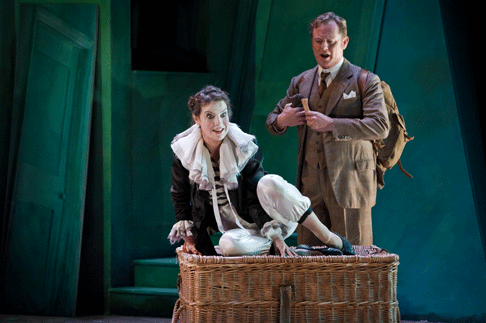 Wendy Dawn Thompson as Mignon and Ryan MacPherson as Wilhelm
Wendy Dawn Thompson as Mignon and Ryan MacPherson as Wilhelm
Director Annilese Miskimmon has adopted a suitably light touch, updating the action to the 1920s, and delighting in the frivolity and sparkle. Her playful approach is complemented by Nicky Shaw’s economical but visually appealing sets; director and designer work well together to introduce some neat dramatic touches. Thus the opening post-theatre party scene sets off with a swing of energy and jollity, dressing room doors dancing gaily to and fro, as a flurry of acrobats, ventriloquists, escapologists, magicians and dancers whizz and whirl across the stage. The limited space is efficiently deployed: at the end of Act 1, the stage is enveloped in murky smoke to transport us to a dusty, crowded railway station, an illuminated sign pointing the way to the platforms; and the burning theatre, engulfed by flames ignited by an increasingly vengeful and raving Lothario, is effectively realised.
As Wilhelm, American tenor Ryan MacPherson was dramatically credible — a handsome Hollywood matinee idol - and displayed a truly pleasing voice across the registers. His fairly light tenor was initially a little grainy when pushing at the top, but as he relaxed he produced a richer, fuller sound, particularly in the closing trio.
Despite some adroit gymnastic feats, as she deftly squeezed herself into the laundry box in which she is imprisoned by the dastardly Jarno, Wendy Dawn Thompson took a little time to warm up vocally and establish her character. But, her Act 2 aria ‘Connais-tu le pays’ revealed a glowing, rich mezzo tone which conveyed Mignon’s innocence and integrity, developing a deeper psychology as her confusion and suffering are revealed.
Baritone Russell Smythe was a rather jaded Lothario. He had some not insignificant intonation problems, although these lessened as he settled into the role; but he did not find a way to effect a transition between Lothario’s introverted suffering and his aggrieved public outbursts, and Smythe’s tendency to bellow to convey both anger and despair reduced our sympathy for the bereaved and lonely man.
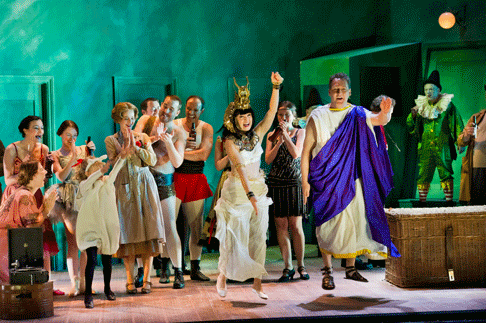 Gillian Keith as Philine and Andrew Mackenzie-Wicks as Laerte
Gillian Keith as Philine and Andrew Mackenzie-Wicks as Laerte
Indian tenor Amar Muchhaka was a likeable Frederick, but the star of the show was undoubtedly, and fittingly, Gillian Keith as the dazzling diva, Philine. Keith relished the giddy theatricality of her show-stopping Polonaise and despatched the coloratura of ‘Je suis Tytania’ with aplomb. Her dressing-room door appropriately sported a glittering star; and it was no surprise that her excessive luggage required the heft of several strapping chaps to hoist it onto the departing train.
Opera enthusiasts can take an infinite number of improbabilities and coincidences in their stride, but there is an innate problem with Mignon in that the plot does not successfully combine or integrate the comic and tragic strands. Occasionally these sat uncomfortably alongside each other. Thus, the ‘play-within-a-play’ performance of A Midsummer Night’s Dream — during which the simple-minded rustics dotingly worship Tytania as she is born aloft upon a crescent moon — was effectively presented (mechanical malfunction adding a further piquant touch), but it was then a rather abrupt switch to Mignon’s increasing distress and despair as she embarked upon a suicide dash into the flames.
Despite this, and the libretto’s somewhat uneven dispersal of dramatic events, energetic conducting by Andrew Greenwood drew lively playing from the Northern Chamber Orchestra and kept the show moving swiftly on to its happy, if slightly implausible, resolution.
Similar imaginative leaps were demanded of the audience by Olivia Fuchs’ production of Handel’s Saul the following evening. In a programme article Fuchs notes that Charles Jennens’ libretto, based on the first book of Samuel, reflects some of the social and political events of the day, and that the challenge is to “[find] another context closer to our own experience that reflects the universal concerns of nationhood, power and its subsequent abuse”. Fuchs thus updates the biblical action to post-WW2: Saul is a physically commanding but psychologically insecure US president and Daniel a dashing young pilot, fresh from heroic exploits which, judging from the exploding mushroom cloud in the opening visual sequence, presumably included dropping the nuclear bomb on Hiroshima.
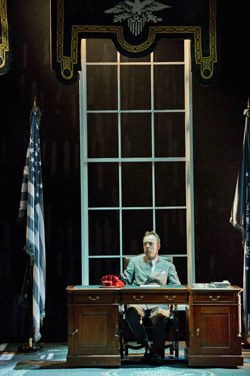 Jonathan Best as Saul
Jonathan Best as Saul
While, generally, attention to detail is a good thing, it is possible to be overly specific and precise. Certainly Saul, composed shortly after the Glorious Revolution, raises questions about leadership, the legitimacy of rule and dynastic succession, and explores the effects of power upon the individual and the community. Such abstract concepts translate with relevance to our own age, but Fuchs’ declaration that Saul “shows us the way a nation establishes itself as a superpower, how it justifies war as a means of defence and a way of establishing national identity” seems to be taking things a bit too far. By pinpointing particular moments in twentieth-century history with such precision, Fuchs and designer Yannis Thavoris try to create parallels that are not always credible or sustainable: the victory chorus which opens Act 1 is now a VJ parade, the subsequent conflict with the Philistines becomes the Korean war (making nonsense of the text — who are the ‘Uncircumcised’ in 1950?), and Daniel only narrowly avoids a ‘Lewinsky moment’ in the Oval Office in Act 2!
Another problem, inherent in the genre, is what to do with the chorus. In opera seria, the ‘chorus’ was not a separate entity but simply an ensemble for the soloists, usually performed as a tableau at the start or end of each act before the sequence of individual da capo arias; but in his oratorios, Handel uses the chorus as a sort of Greek chorus which comments on the action as it develops and provides a moral benchmark for the audience. The difficulty in a dramatic staging of the work is therefore how to integrate the chorus plausibly in the action. Choreographer Clare Whistler certainly tried to suggest the chorus’ unity of thought and judgement, ritualistically assembling the members in sequence, using imitation and repetition of movement to indicate collective judgements and beliefs. Yet, there was frequently too much fuss and busyness: umbrellas were certainly requisite outside the house during an unseasonable wet week, but were they really essential as a prop for a well-drilled choral routine? The ‘meaning’ of such gestures, like the twisting hand movements that opened Act 2, was often obscure or plain daft (were the chorus’ lime green hands supposed to indicate Saul’s envy which the people condemn?). Moreover, they distracted both the chorus from watching the beat, and the audience from focusing on what was otherwise some fine ensemble singing.
Jonathan Best was strong in the title role, conveying the paranoia and jealous anguish of the eponymous ruler with intelligence and conviction. Robert Murray presented a thoughtful portrait, musically focused and dramatically engaging; but as Saul’s two daughters, Merab and Michal, Elizabeth Atherton and Ruby Hughes respectively made less dramatic impact and Hughes’ projection was rather weak at times. Most impressive of the cast was Anne Marie Gibbons, a stunning David, who used her burnished lower register to convey significant emotional depth as the young man experiences fresh hopes, passions and fears. One wonders, though, despite Gibbons’ beautiful legato line and sensitive decorative embellishments, whether the role should not really be taken by a countertenor, as Handel envisaged. In a silent role, as the Witch of Endor, Andrew Mackenzie-Wicks was dramatically effective (he was similarly assured in the small role of Laerte in Mignon the previous evening).
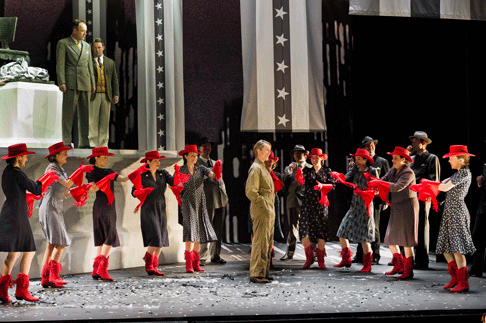 Jonathan Best as Saul, Robert Murray as Jonathan, Anne Marie Gibbons as David, with the Festival chorus
Jonathan Best as Saul, Robert Murray as Jonathan, Anne Marie Gibbons as David, with the Festival chorus
Conducting the Orchestra of the Sixteen, Harry Christophers established a lively momentum in Act 1 but, while alert to the musical details, he was not entirely successful in sustaining dramatic urgency, particularly through the series of slow arias in Act 3. One innate problem is that the musical involvement of David actually decreases in inverse proportion to his dramatic significance and growing power. And, Christophers wasn’t helped by the frequent hiatuses necessitated by numerous scene changes, including one (presumably unintentional) long pause between the scenes of the final act, which destroyed the musical and dramatic impetus.
In addition to the in-house productions and operas presented by visiting companies, the Festival offers a Literary Series, walks, a vibrant Fringe scene, and a concert programme, Mainly Music. On Tuesday 18th July the Frith Piano Quartet were on fine form in a recital of both well-known and unfamiliar chamber music by Dvořák. Taking advantage of the presence of a harmonium in the Pavilion Arts Centre, they began with the seldom performed Five Bagatelles, Op.47, Alistair Young’s warm harmonium tones blending sympathetically with the folk-inspired melodies of the strings, which are developed in variation form through a range of tempi and moods. Young was replaced by pianist Benjamin Frith in Dvořák’s second Piano Quartet in E-flat Op.87. The precision of the ensemble, led confidently and with stylistic panache by Robert Heard, was impressive: the instrumentalists responded sensitively as individual lines rose and fell within the energetic textures, Frith’s vigorous piano motifs never over-shadowing the strings. Louise Williams enjoyed the opportunities afforded by the composer to display her rich viola tone, while ‘cellist Richard Jenkinson provided strong rhythmic impetus, his athletic and precise pizzicato particularly note-worthy.
The 2012 Festival promises more such delights, with a programme scheduled to include more Handel, Strauss’s Intermezzo and Sibelius’s The Maiden in the Tower.
Claire Seymour
Cast Lists:
Mignon
Mignon: Wendy Dawn Thompson; Philine: Gillian Keith; Wilhelm: Ryan MacPherson; Lothario: Russell Smythe; Laerte: Andrew Mackenzie-Wicks; Jerno: Mark Holland; Frederick: Amar Muchhala. Conductor: Andrew Greenwood. Director: Annilese Miskimmon. Designer: Nicky Shaw. Lighting: John Bishop. Buxton Opera Festival 2011, Saturday 16th July 2011.
Saul
Saul: Jonathan Best; Jonathan: Robert Murray; David: Anne Marie Gibbons; Merab: Elizabeth Atherton; Michal: Ruby Hughes; Witch of Endor: Andrew Mackenzie-Wicks; Ghost of Samuel: Andrew Slater; High Priest: Andrew Mackenzie-Wicks; Doeg: Philip Gault. Conductor: Harry Christophers. Director: Olivia Fuchs. Designer: Yannis Thavoris. Choreographer: Clare Whistler. Lighting designerJohn Bishop. Buxton Opera Festival 2011, Sunday 17th July 2011.
image=http://www.operatoday.com/mignon_gillian-keith-276.gif image_description=Gillian Keith as Philine [Photo by Robert Workman courtesy of Buxton Opera Festival] product=yes product_title=Ambroise Thomas: Mignon; Georg Frederic Handel: Saul product_by=See body of review for cast lists. product_id=Above: Gillian Keith as PhilineAll photos by Robert Workman courtesy of Buxton Opera Festival
July 21, 2011
Sciarrino: Luci Mie Traditrici
by Andrew Clements [Guardian, 21 July 2011]
Sciarrino's opera may be only a little over a decade old, yet this is already the third version of Luci Mie Traditrici, and the second on the Stradivarius label, to appear on disc. Unlike its predecessors, though, this recording comes from stage performances - at last year's Montepulciano festival - and has a dimension of vivid theatricality that makes the others seem strait-laced in comparison.
Inside a Master Class: Breathe, Punctuate, Forget Led Zeppelin
By Erik Piepenburg [NY Times, 21 July 2011]
IN the Terrence McNally play “Master Class,” the opera diva Maria Callas (played by Tyne Daly) understands pedagogy to mean wiping the floor with young students’ ambitions.
“Try isn’t good enough,” Callas scolds. “Do.”
July 19, 2011
Opera in Contract Spat
By Erica Orden [WSJ, 19 July 2011]
Unions representing New York City Opera performers have questioned whether the company's intention to vacate its home at Lincoln Center for the Performing Arts is prudent. Now they are questioning whether it's legal.
Havergal Brian’s “Gothic” Symphony
Havergal Brian (1876-1972) is a cult figure in British music who attracts an intense following, even though his music is rarely performed and existing recordings are of not of the highest standards. He’s better known by reputation than by listening experience. Indeed, it’s this very air of exclusivity that’s part of his appeal. BBC Prom 4 was a historic watershed in Brian reception, because it gave Brian maximum possible publicity, and the best performance to date.
This was a truly spectacular, extravagant event. Brian’s “Gothic” Symphony is apparently in the Guinness Book of Records for being the biggest symphony ever written, and only the BBC Proms can provide the resources to do it justice. Thus, this Prom was a once-in-a-lifetime experience, a historic occasion that wasn’t to be missed. It was a form of total theatre that will be remembered for decades.
One third of the massive Royal Albert Hall was reserved to accommodate the sheer number of performers, almost a thousand in all. Nine choruses, no less, visually impressive, especially the women’s choir in lavender, and the children’s choirs in white. Two main orchestras, the BBC National Orchestra of Wales and the BBC Concert Orchestra. Two “timpani orchestras”, as opposed to “symphony orchestras”, positioned at the sides of the auditorium, between the choristers and audience. Those sitting near them may be deaf for days. And, like a Colossus above them all, the mighty Royal Albert Hall Willis organ, with its 9,997 pipes and 149 stops, the largest in Europe.
Martyn Brabbins conducted the gargantuan forces with aplomb. He’s braved the dense jungle of this score like a fearless explorer mapping unknown territory. He’s clearly prepared the work thoroughly, searching out the main features in this bewildering terrain. Brian’s “Gothic” is a strange Leviathan which has defeated the best efforts of many, so Brabbins deserves a medal for persistence and dedication.
Brabbins focuses on the many details which build up to form the dense undergrowth. A flurry of harps, for example, and a bizarre chorus of xylophones, springing out unexpectedly, like exotic birds startled into flight. The whole symphony seems to be built from details like this, an accumulation whose object is to amass as many pieces as possible — not a jigsaw, for the ideas don’t really cohere. So Brabbins’s carefully thought out detail brings out the endless proliferation that gives this symphony its charm.
Brian was a self-taught, almost eccentric character who wasn’t particularly bothered by the practicalities of performance. There are many ideas in this symphony, but they are briefly glimpsed and don’t develop. On paper, they may look good, but they don’t necessarily make much sense in practical performance. For example, the timpani orchestras, backed by very loud brass. At first they call out to each other across the expanse of the auditorium. Then one falls more or less silent thereafter.
Brian’s Gothic has been compared to Mahler’s Eighth Symphony, on the basis that the latter was marketed as the “symphony of a thousand”, but the comparison is nonsense. The label was a PR ruse. Mahler’s focus was on spiritual meaning. Although Mahler’s structure is unorthodox, there’s a powerful trajectory that pulls it forward. The inspiration behind Brian’s symphony isn’t consistent. Liturgical texts are used, but the thrust isn’t particularly spiritual. Brian is certainly ambitious, quoting Goethe’s Faust on his title page, (“Whoever strives with all his might, that man we can redeem”), but the energy dissipates.
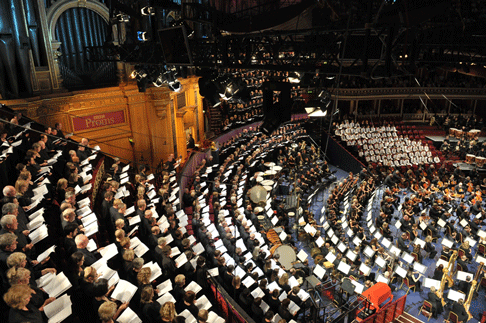
For example, in the final movement, the ‘Te ergo quaesumus’, Alastair Miles intones lines that waver upwards and down, perhaps in homage to Orthodox chant, but the orchestra then plays a parody of jazz swing. Sometimes contrasts have reason, but in this symphony they seem to exist for variety’s sake. When Susan Gritton sings ‘Judex crederis esse venturus’ from way up in the rafters, it’s a truly sublime moment — magnificent singing, magnificently theatrical. But the rest of the movement consists of that 4-word sentence alone, and it’s quickly dispensed with in favour of meaningless extended vocalise. In all three major Proms concerts so far (Janáček’s Glagolitic Mass and Rossini’s William Tell) the tenor parts have been fiendishly difficult. Peter Auty deserves recognition for valour, since he surmounted Brian’s extreme demands for his part. Christine Rice sang part well, but Brian leaves the part curiously underwritten.
This performance of Brian’s “Gothic” symphony was hugely enjoyable because it worked remarkably well as theatre. Brian himself may not have anticipated the concept of sonic architecture quite in the way that others — including Stockhausen, whom Brabbins also conducts well — but the BBC Proms and the Royal Albert Hall can work wonders. Brabbins and his multitude deserve a great deal of credit, but so too, do the organizers who made this possible in the first place — a thousand performers and a huge array of instruments. Moving this army must have been a logistic nightmare. Many of these choirs are major names on the choral scene, and were brought in from all over the country.
Hopefully, Brabbins’s Proms performance of Brian’s “Gothic” will be recorded, if only to recoup the enormous costs. It’s a superlative way into the symphony particularly as so little of this music is available. Fortunately, the Havergal Brian Society website is so comprehensive that now everyone can become familiar with his work even if they haven’t heard it.
Every single concert in the BBC Proms 2011 series is broadcast live online and on demand for several days, complete with facsimile programmed notes. For more details, please visit the BBC Proms website.
Anne Ozorio
image=http://www.operatoday.com/The-Gothic---Prom4-2011-2.gif image_description=Photo by Chris Christodoulou.courtesy of the BBC product=yes product_title=Havergal Brian: Symphony no. 1 The "Gothic". product_by=Soprano: Susan Gritton, Mezzo-soprano: Christine Rice, Tenor: Peter Auty, Bass: Alastair Miles, Organist: David Goode. Children's Choruses: Eltham College Boys' Choir, Alastair Tighe chorus master, CBSO Youth Chorus, Julian Watkins chorus master, Southend Boy's and Girls' Choirs, Roger Humphrey, chorus master. Chorus 1: Brighton Festival Chorus, Huddersfiled Choral Society, London Symphony Chorus, Joseph Cullen, chorus master. Chorus 2: BBC National Chorus of Wales, The Bach Choir, Côr Caerdydd, Adrian Partington, chorus master. BBC National Orchestra of Wales, BBC Concert Orchestra, Martyn Brabbins, conductor. Prom 4, BBC Proms. Royal Albert Hall, London, 17th July 2011. product_id=All photos by Chris Christodoulou.courtesy of the BBCJuly 18, 2011
Tosca, Royal Opera House/La Rondine, Opera Holland Park
By Rupert Christiansen [Daily Telegraph, 18 July 2011]
Bitter experience suggests that star-studded and tremendously expensive opera productions sponsored by luxury brands turn out to be sad artistic disappointments, and I had a cynical feeling that this Rolex-cushioned Royal Opera revival of Tosca would turn out to be a dud.
Guillaume Tell, BBC Proms
No one would claim that, Riccardo Muti notwithstanding, ‘serious’ Rossini was in fashion. On the basis of this Proms concert performance of Guillaume Tell, I cannot say that I feel deprived. Indeed I should express unalloyed relief, were it not for the fact that its place tends to be assumed by less rather than more interesting works. Schiller’s wonderful play, Wilhelm Tell, becomes something tedious and uninvolving – and, moreover, tedious and uninvolving at very great length. One gains no real sense of the characters as characters, of why one should or even might care about them. Now it might well be that individual psychology is not the point; it certainly is not in, say, Fidelio. Yet there one has a noble, overwhelming instantiation of the bourgeois idea of freedom at its greatest. Here one has interminable exchanges between men from different Swiss cantons ramble on uninspiringly about a Swiss fatherland, but never with fervour, lest Rossini’s monarchist protectors become alarmed. The nationalism – or, perhaps better, caricatured anti-German sentiment – is so preposterous that one can only hope nobody took it seriously even at the time. Certainly if this were a German work and the boot were on the other foot, we should expect howls of protest. The romantic element, between the Habsburg princess Mathilde, who rejects the wicked governor Gessler, and Arnold Meuchtal, a Swiss conspirator, is implausible – and implausible at great length. And how much lolling about in the sun by peasants can anyone reasonably be expected to take? Music can express languor very well; think of Debussy. Here, however, it less expresses boredom than becomes lamentably nondescript – at, you guessed it, inordinate length. Indeed, the entire first act could be cut without the slightest harm to the plot; on this occasion, it was the fourth that suffered, being cut down to twenty minutes, creating the rather odd impression of a rush to the finishing line far too late. I have never attended an operatic performance at which so many in the audience were constantly checking their watches, nor, indeed, in which so many leaped to their feet and departed, as soon as the performance was over, not even waiting to engage in the most desultory applause.
So much for the work: I was genuinely interested to have the rare opportunity to hear it, but now do not feel the need to do so again. What of the performances? Antonio Pappano had his moments, perhaps more so in the crowd control of the choral exchanges, or some of the recitative passages. Yet I could not help but wonder what a conductor such as Muti would have brought to the work; perhaps his iron grip might have had one believe in something as implausible as this. Even the overture failed to impress. It is sectional, of course, but surely a conductor ought to try to mask that just a little; there was no discernible attempt at transition whatsoever. The storm section was absurdly hard-driven, and the whole quite lacked charm, despite some fine woodwind playing from the Santa Cecilia orchestra. Though the strings on occasion sounded a little feeble here, they were on good form for most of what was to come. To have members of the orchestra take solo bows following the overture was straightforwardly bizarre.
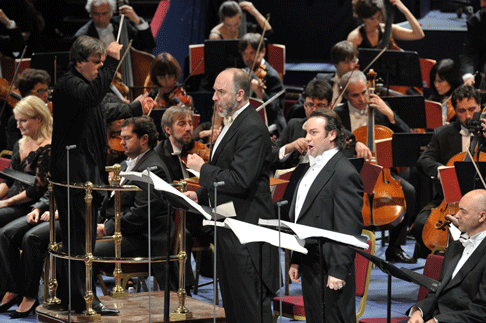 Michele Pertusi (William Tell) and John Osborn (Arnold Melchthal)
Michele Pertusi (William Tell) and John Osborn (Arnold Melchthal)
Vocal performance remained. The choral singing was generally very good indeed, and improved as the night went on: Ciro Visco is clearly an excellent choral trainer. Michele Pertusi, sad to say, made a dull Tell. Someone charismatic in this role might have pulled off a miracle, but that was not to be. Most of the rest of the cast outshone him, not least John Osborn’s outstanding Arnold, his fourth-cast aria, ‘Asile héréditaire’, proving the evening’s high-point: sweetly and elegantly sung. (Pappano should not, however, have allowed the prolonged intrusion of applause thereafter.) Elena Zanthoudakis sang well as Jemmy, Tell’s son, though her French vowels often left a good deal to be desired. The wideness of Patricia Bardon’s vibrato as Hedwige, Tell’s wife, would not have been to all tastes, and was certainly not to mine. Bar the odd unfortunate moment, such as a culiminating shriek in her Act II Scene 3 exchange with Arnold, Malin Byström proved impressive as Mathilde, her coloratura almost always precise and tasteful, though the end of the third act brought some notably flat singing. Nicolas Courjal’s Gessler in many ways came the closest to a convincing portrayal of character, certainly as close as one could imagine, suavity of line and demeanour suggesting a more sophisticated malevolence than one might have expected.
The singing, then, or rather some of the singing, was the only real point of interest. I can imagine that a staged performance with an outstanding conductor – a Muti or an Abbado – and an interesting, properly deconstructive production – from, say, a Stefan Herheim or a Peter Konwitschny – might work wonders, though I suspect one would tend to think that such talents would be better employed elsewhere. At least the celebrated scene with the apple, for which everyone not unreasonably appeared to be waiting, might elicit some sort of impact, whereas in concert, one merely notes the lack thereof. I am far from a Rossini devotee, but give me the sparkle of Il barbiere di Siviglia any day over this, and if it must be grand opéra, then Rienzi, which boasts some truly extraordinary music, let alone the masterpieces of Berlioz. Even Meyerbeer if necessary… I could not help but think of Wagner’s Opera and Drama, in which he portrays nineteenth-century opera as having degenerated into a chaotic farrago of different elements, randomly mixed and presented, permitting each spectator choosing whatever took his fancy: ‘Here the dainty leap of a ballerina, there the singer’s daring passage-work, here the set-painter’s brilliant effect, there the amazing eruption of an orchestral volcano.’ In this way, Wagner, claimed, composers such as Rossini had become the toast of the ‘entire civilised world’, and acquired the protection of Prince Metternich (the Austrian Prince Metternich, be it noted) and his European System, reinforcing rather than questioning the social order. Such a work, then, is undoubtedly of historical importance; its modern-day interest, however, largely escaped me.
Mark Berry
image=http://www.operatoday.com/Antonio-Pappano-2---Prom-2%2C.gif image_description=Antonio Pappano conducts the Orchestra and Chorus of the Academy of Santa Cecilia [Photo by Chris Christodoulou.courtesy of the BBC] product=yes product_title=Gioacchino Rossini, Guillaume Tell product_by=William Tell: Michele Pertusi; Arnold Melchthal: John Osborn; Walter Furst: Matthew Rose; Melchthal: Frédéric Caton; Jemmy: Elena Xanthoudakis; Gessler: Nicolas Courjal; Rodolphe: Carlo Bosi; Ruodi: Celso Albelo; Leuthold: Mark Stone; Mathilde: Malin Byström; Hedwige: Patricia Bardon; Huntsman: Davide Malvestio, Chorus and Academy of the Academy of Santa Cecilia, Rome (chorus master: Ciro Visco), Antonio Pappano (conductor). Royal Albert Hall, London, Prom 2, Saturday 16 July 2011. product_id=Above: Antonio Pappano conducts the Orchestra and Chorus of the Academy of Santa CeciliaPhotos by Chris Christodoulou.courtesy of the BBC
July 17, 2011
Glimmerglass’s Annie Get Your Gun: Deborah Voigt descends from Valhalla and makes a hit on Broadway
By David Abrams [CNY Café Momus, 17 July 2011]
It may be a stretch to argue that anything Ethel Merman can do Deborah Voigt can do better. Still, there’s no denying that the Wagnerian soprano hit her target, got her man and won the crowd at Glimmerglass Festival’s opening-night performance Saturday of the Irving Berlin classic.
July 16, 2011
First Night of the 2011 BBC Proms
Last year it reverted to the long-established tradition of a single large-scale work, often but not always choral, with Mahler’s Eighth Symphony . This year we heard an excellent performance of Janáček’s Glagolitic Mass, but with a first half whose programming did not really come off. A fanfare followed by an overture followed by a concerto probably had at least one piece too many, but might have persuaded had the two opening works proved more convincing. It seemed an excellent idea to open with a newly commissioned work and Judith Weir seemed an excellent choice: an often unsung composer whose works have long displayed such fine compositional craft. Stars, Night, Music, and Light , written for chorus and almost the same orchestral forces as Janáček’s mass (minus harps, offstage clarinets, and celesta) sets words from George Herbert’s Man:
The stares have us to bed;
Night draws the curtain, which the sunne withdraws;
Musick and light attend our head.
So far so good, yet the opening kettledrum rolls and brass fanfares signalled a damp squib of a curtain-raiser. My friend put it succinctly: ‘a cross between Vaughan Williams and MGM’. And whilst there seemed to be an aspiration to a briefer (three-minute) version of RVW’s Serenade to Music, it was quite without that work’s magic. ‘Lush’ tonal harmonies, too shop-soiled by popular entertainments for us to be able to take them anything other than ironically, jostled with descending scales on the organ that sounded as if straight from the music hall: Poulenc, but again apparently without irony. There was a little more bite from the brass, but the overall effect was of camp without wit. I suspect that this is destined to remain an ‘occasional piece’.
The following Brahms Academic Festival Overture was heard with Sir Malcolm Sargent’s additional part — restoration, if you will — for chorus at the close: the ‘Gaudeamus igitur’, with an ‘occasional’ final line from Sargent: ‘Vivant academiae musicale!’ (‘Long live music colleges!’) If you like that sort of thing, that is the sort of thing you will like; it sounded a bit like an attempt to resurrect a 1950s world of school prize days. Jiři Bělohlávek took the overture at so swift a pace, despite generally alert playing from the BBC Symphony Orchestra, that it actually sounded quite frantic at times: a first for me and, I hope, a last.
That over with, we were treated to an estimable performance of Liszt’s Second Piano Concerto. If Liszt is not having quite the anniversary year some of us had hoped for — where is Christus or The Legend of St Elisabeth? — then the Proms are to be commended for featuring his music throughout the season. Bělohlávek and the BBC SO immediately sounded much more at ease; I had the impression, rightly or wrongly, that the piece had benefited from greater rehearsal time than the Brahms. Moreover, string tone, previously somewhat wiry, now mellowed and blossomed. That was before Benjamin Grosvenor, at nineteen years old apparently the youngest Proms piano soloist, had played a note. There was nothing jejune about Grosvenor’s performance, which deserved to be taken seriously indeed. From the outset, his pearly piano tone rendered Liszt’s line both clear and meaningful, rhythmic alertness from all concerned adding much to that sense of direction and meaning. Much of the concerto, quite rightly, was taken as chamber music — the real reason that Liszt wrote relatively little ‘pure’ chamber music is that, like Wagner’s, it is there in his larger-scale works — with piano and orchestral contributions nicely shaded, never unduly forced. When the music turned martial, such transformation was never overstated: that vulgarity of which Liszt, not entirely unjustly, has often been accused was not present on this occasion. Indeed, Bělohlávek and Grosvenor proved well attuned to the subtleties of Liszt’s transformational technique, which was to cast such a shadow over the course of twentieth-century music, to the Second Viennese School and beyond. Virtuosity never appeared as mere virtuosity: even the diabolical had something of the classical to it. True, one did not experience the electric shock of Sviatoslav Richter’s glissandi, but one encountered a pianist who seemed to have as sure a grasp of Liszt’s form. An auspicious Proms debut indeed!
The Glagolitic Mass was given in a new edition by Jiří Zahrádka and Leoš Faltus, which apparently restores passages simplified prior to the first performance in December 1927. According to the programme, the changes included simplification of rhythms, removal of the ‘offstage’ marking for a passage for three clarinets in the ‘Věruju’ (Credo) and cuts to both that movement and the ‘Svet’ (Sanctus). More may be read here concerning the edition, which Zahrádka modestly terms ‘an informative curiosity of sorts’. For what it is worth, I tend to prefer the practice of opening the Mass with the ‘Intrada’, but here we heard the ‘Introduction’, which to my ears fizzles out by comparison. Perhaps it remains more important, however, to recount that the Mass received a performance as impressive as that of the Liszt concerto. One can often tell a great deal — as, indeed one did during the Liszt — from the opening bars of a performance. Such was also the case here, for sharpness of attack, command of the composer’s idioms, and a fine ear for what one might call the ‘pastoral’, did the term not seem so constricting in Janáček’s all-embracing sound-world, characterised those bars. If the conclusion of the Introduction sounded somewhat sedate, that was my only real cavil. The ‘Slava’ (Gloria) made it clear, as did so much of the rest of the score and its performance, that this was a God of Nature, of wide-open spaces, of pantheistic, Cunning Little Vixen-like wonder. Oddly, then, one proceeds the passages referring to Christ almost as if they were tales of an ancient saga — Bartók’s Cantata Profana came to mind, though it was written slightly later — rather than items of faith relating to the second person of the Holy Trinity. Or at least that is what I did on this occasion, guided no doubt by so fresh and ‘open’ a performance. Stefan Vinke’s delivery was not without strain, but one can hardly expect Janáček’s lines to be despatched otherwise: crucially, there was imparted a sense of wonder, of intoxicated lyricism. Much the same could be said of Dagmar Pecková’s contributions. Those soloists, the tenor in particular, have the lion’s share of the solo work, but Jan Martiník and Hibla Gerzmava impressed where they could too. It was, though, the combined forces of the BBC Symphony Chorus and BBC Singers who made the greatest vocal impression of all, whether in tossing cries of glory from male to female sections, and back again, or in the beautiful a cappella singing of the ‘Agneče Božij’(Agnus Dei), in which the chorus sounded as dynamically malleable as the orchestra. There was a great deal to praise from the BBC SO too, whether in solo work (the three pairs of kettledrums, or Stephen Bryant’s sweet-toned violin solo at the opening of the ‘Svet’) or in the almost overwhelming closing peroration of the Intrada. The dark, even sinister imprecation of the ‘Agneče Božij’ (no ‘Dona nobis pacem’ here, be it noted) was indeed first and foremost orchestral. David Goode’s performance, both during the ‘Allegro’ organ solo and elsewhere, was first-class, well-chosen registration and dextrously-navigated changes of manuals turning the monster of the Royal Albert Hall organ into a musical instrument, and a modernistically interesting musical instrument at that. There was no comparison with the puny electronic instrument Sir Colin Davis’s recent Barbican performance had to endure. And behind, or rather in front of, the vast forces, was the wise, guiding hands of Bělohlávek. He has sounded out of sorts in too many BBC concerts; yet, in the right repertoire, whose idiom he clearly understands, and which he evidently relates to Slavonic (or, more often, Czech) speech rhythms, he remains an impressive musician. For the Glagolitic Mass to come across in so apparently ‘natural’, unforced, yet exultant fashion must have been in good part his doing.
Mark Berry
image=http://www.operatoday.com/benjamin-grosvenor.gif image_description=Benjamin Grosvenor [Photo courtesy of the BBC] product=yes product_title=Judith Weir: Stars, Night, Music, and Light (BBC commission, world premiere); Johannes Brahms: Academic Festival Overture, op.80 (arr. Sir Malcolm Sargent); Franz Liszt: Piano Concerto no.2 in A major, S.125; Leoš Janáček: Glagolitic Mass (September 1927 version). product_by=Benjamin Grosvenor (piano); Hibla Gerzmava (soprano); Dagmar Pecková (mezzo-soprano); Stefan Vinke (tenor); Jan Martiník (bass); David Goode (organ); BBC Singers; BBC Symphony Chorus (chorus master: Stephen Jackson); BBC Symphony Orchestra ; Jiři Bělohlávek (conductor). Royal Albert Hall, London, Friday 15 July 2011. product_id=Above: Benjamin Grosvenor [Photo courtesy of the BBC]July 15, 2011
Aix-en-Provence Festival
By John Allison [Daily Telegraph, 15 July 2011]
Now into the second season of its four-year residency at the Festival d’Aix-en-Provence, the London Symphony Orchestra has been extending its reach at this most prestigious of French musical events.
Seven Angels, London
Bedford is one of the most promising British composers, some of whose work has almost become basic repertoire, by new music standards. He’s the first composer-in-residence at the Wigmore Hall. For more background, please read the interview he gave recently to Opera Today.
Seven Angels is loosely based on John Milton’s Paradise Lost, but it’s not a literal, or even literary account. It’s not even a typical opera where singing leads music. Instead, the drama unfolds from the music, almost more like an extended tone poem, with voices. This is a work by a composer who is primarily a musician, although he has a special affinity for writing for voice.
Seven Angels is allegory, and like allegory, it works obliquely. Seven angels descend to earth and find it barren. What has happened to the Garden of Eden? The angels don’t know, so they use their intuition to imagine backwards how things might have come to pass. It’s not narrative in the usual sense, as the characters are building the story as they go along. They don’t know the answers but work towards them by listening and using their instincts, as should we. This is more than just a tale about of environmental ruin. The noisiest section in the work was inspired by a real conference where politicians debated what to do with starving nations, while they themselves feasted and made empty promises. Because the vocal writing here is so dramatic, it’s easy to mistake this posturing for the message of the opera. The angels are imagining themselves as conference delegates and shout worthy slogans. But the point is that the politicians’ words are hollow.
Like the expressive markings on a score, words are an aid to interpretation but they aren’t the music itself. Because the staging, by John Fulljames and The Opera Group, was devised as the music itself developed, the production gives fairly strong clues as to what this opera is really about. The stage is covered in books — hundreds of books, millions of words. The background is a filmed projection of printed pages. Sometimes the words are legible, sometimes not — quantity rather than quality. The subjects are irrelevant. This is a deluge of unprocessed data, a cacophony of text without meaning.
Significantly, the angels don’t read books to find out the history of the planet. They follow their instincts and act out in role-play. Two angels become King and Queen! If there were two, they made a third. So another angel becomes The Prince. He’s voracious, obsessively tearing pages from books and stuffing them into his mouth, until his belly grows so large it seems he’ll burst. He’s consuming, but consuming what? Is it content that he’s consuming, or paper and pages, irrespective of sustenance?
Only when the books start to run out does the Prince see himself, reflected in the metal at the bottom of his plate. Later, the angels act out a Conference where authority figures opine piously about environmental waste, in stylized declamation. The table they’re sitting at is made of books, piled high. Then the books begin to topple, like the Tower of Babel. Yet again, the point is that words alone fail to communicate.
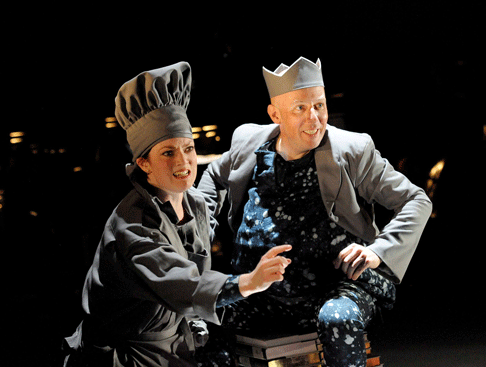 Rhona McKail as the Waitress and Christopher Lemmings as the Prince
Rhona McKail as the Waitress and Christopher Lemmings as the Prince
Bedford’s Seven Angels as a musical evolution whose secrets are encoded in the orchestration, both vocal and instrumental. It should be studied in concert performance to focus on the musical logic, for this writing is subtle and inventive. The opera starts with a mysteriously opaque murmur that gradually takes shape. Just as the Bible describes Seven Days of Creation, the music moves in plateaux, ideas developing in groups, then moving onwards to new planes. Great contrasts. As the angels get into their imaginative stride, the pace quickens with brightly agitated ostinato, moments of wit and exuberance, before the angels gradually come to realize the tragedy that has happened.
The orchestration is quite singular. Low-pitched winds and trumpet, four violas, contrabass and bassoon/contrabassoon, piano and a panoply of percussion and sound effects. Darkness, mystery, ambiguity. What is that mournful wailing towards the end? It is the song of the contrabassoon, bizarre but surprisingly beautiful. Percussion and sound effects like the analogue radio create atmospheric complexity. In this context, even the familiar sound of a violin seems shocking, when we’ve been lulled by the four viola chorus.
There is a strong integration between vocal and non-vocal forces. The violas rumble, a singer snores. The angels stand in line, snapping the pages of books, so the sound becomes another form of percussion. It’s remarkably effective, and might be an element of staging that survives into future productions. When the angels return to the heavens, there’s a wild whirring sound as if time itself were being reversed. Extraordinarily vivid.
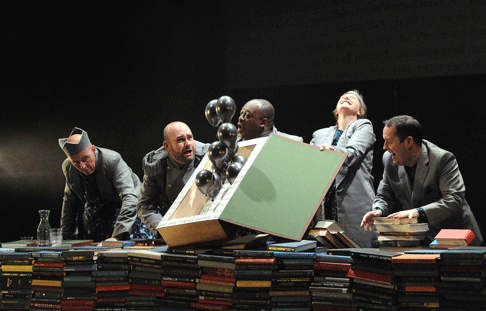 (Left to Right) Christopher Lemmings as the Prince, Owen Gilhooly as the General, Keel Watson as the King, Emma Selway as the Queen, Joseph Shovelton as the Industrialist
(Left to Right) Christopher Lemmings as the Prince, Owen Gilhooly as the General, Keel Watson as the King, Emma Selway as the Queen, Joseph Shovelton as the Industrialist
This libretto, by Glyn Maxwell, “sings” even on the page, for text that is sung is music, not mere shapes on a page. Bedford translates it extremely sensitively. Each angel is distinctive, and lines can be heard clearly when needed, retreating into the whole as instruments do, when a more diffuse effect is needed. No heroic feats of gymnastic singing needed. These angels are feeling their way into human situations. The lines are semi-conversational, with occasional flights of wild fantasy (the queen in particular — a telling psychological touch). This gives expressive freedom and must make it a pleasure to sing. I can imagine whatSeven Angels might be like with truly top rank singers, but these communicate well. It’s almost an anachronism to refer to these singers as “cast” because they function like the musicians of the Birmingham Contemporary Music Ensemble do, individuals as part of a whole unit. Nicholas Collon conducts.
For an opera where musical values mean so much, the staging is integral to the production. I specially loved the images of the cosmos, white specks of light flickering in darkness, replicated in filmed projections and in the costumes the singers wear. Grey jackets, like the ash on the barren desert they visit. Books are lined up in rainbow colours: an image of the Paradise that’s been lost. Luke Bedford’s Seven Angels is how opera should be done, libretto and staging growing with the music from an early stage. It’s an extremely rewarding experience, much more emotionally satisfying than a lot of recent new opera. It’s not, however, quick-fix like musical fast food, to be consumed mindlessly. The finest meals are the ones that nourish, not the ones that come in fancy plastic packaging.
Anne Ozorio
image=http://www.operatoday.com/Seven_Angels114_1.gif image_description=Christopher Lemmings as the Prince [Photo by Alastair Muir courtesy of The Royal Opera] product=yes product_title=Luke Bedford: Seven Angels (Libretto: Glyn Maxwell) product_by=Angel 1/Waitress: Rhona McKail; Angel 2/The Queen: Emma Selway; Angel 3/The Chef/Preistess: Louise Mott; Angel 4/ The Prince: Christopher Lemmings; Angel 5/The Porter/Industrialist: Joseph Shovelton; Angel 6/The Gardener/General: Owen Gilhooly; Angel 7/The King: Keel Watson. Birmingham Contemporary Music Group. Nicholas Collon. Director: John Fulljames. Designer: Tadasu Takamine. Lighting: Jon Clark. Projection: Ian William Galloway. Linbury Studio Theatre, Royal Opera House, London, 12th July 2011. product_id=Above: Christopher Lemmings as the PrinceAll photos by Alastair Muir courtesy of The Royal Opera
July 13, 2011
Rinaldo at Glyndebourne
The catch is that the staging is bizarre. Baroque is, by nature, bizarre and “fantastikal” to use antique terminology. Baroque audiences went to the opera to be stunned by spectacular feats and outrageous plots. Rinaldo has inherent dramatic promise — malevolent magic, beauties and heroes, exotic strangers, sex, battlefields and scene changes so extreme that they couldn’t be done literally, especially given the limits of baroque stage production. In many ways, baroque audiences had greater tolerance for fantasy than we do now.
Rinaldo is set in the Crusades but has nothing to do with history, religion or even common sense. By removing the hero Rinaldo, the defenders of Jerusalem think they can end the war. So Almira magics him off to an enchanted island, far from the deserts around Jerusalem. Strange Realpolitik. Goffredo and other Christians rescue him and all ends well.
So why the literal staging in this new production directed by Robert Carsen, designed by Gideon Davey? It predicates on the notion that Rinaldo is a schoolboy in a boarding school, who gets bullied by his classmates and caned by his teachers. Indeed, caning recurs frequently in this production, which does make one wonder. The schoolboy concept is largely irrelevant to the very adult, sophisticated nature of Handel’s narrative, and feels forced and infantile.
The sirens don’t need to be coy schoolgirls, and the sight of Almirena in a maxi skirt gymslip is just absurd. The best images would work fine without any schoolboy silliness. For example, Rinaldo and his friends march off not on horses but on bicycles, Rinaldo suspended in the air on high wires. Had they been dressed as warriors, the irony would have been even more pointedly irreverent.
Although Rinaldo is funny, its deeper levels would not have been lost on baroque audiences. Handel, through Torquato Tasso, is also obliquely mocking the futility of war and power games. If even Almira the dominatrix Queen can make up with ferocious philanderer Argante, there’s hope for all.
Ottavio Dantone conducted the Orchestra of the Age of Enlightment, one of the finest specialist period instrument orchestras in the world. Extremely high playing standards, though I would have liked Dantone to have injected more punch overall, though the Battaglia was vivid. Handel’s instrumentation is lively and inventive. Harpsichord, not only as continuo but as a quirky voice in itself, and in this acoustic, assertively clear. Good growling percussion and brass for thunder and battle. I was so intrigued by the bird-like instrumentation around Almirena’s “Augelletti, che cantate”, that I went up to the pit at the interval to check what it was.The musician wasn’t there but other members of the orchestra were enthusiastic. “It’s a sopranino”, someone said. “Not a flute, not a recorder”.
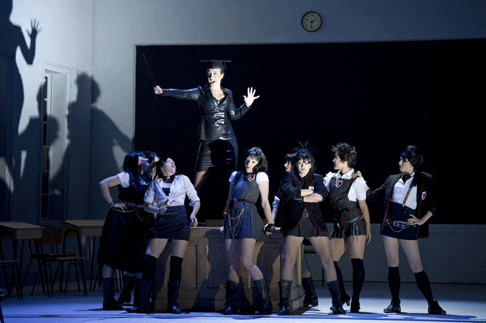 Brenda Rae as Armida with Glyndebourne Chorus and dancers
Brenda Rae as Armida with Glyndebourne Chorus and dancers
Sonia Prina sang Rinaldo. She’s a very experienced Handel singer, so the production was perhaps designed around her, much as the recent Glyndebourne Die Meistersinger von von Nürnberg reviewed here, may have been created to enhance Gerald Finley’s voice. She and director Carsen have worked together before. Prina’s short, compact and sassy, so looks convincing as a schoolboy, Hers isn’t a transcendentally glowing Rinaldo but she has stamina. In “Cara Sposa”, she stretched the long vowels sturdily.
As Armida as Dominatrix, Brenda Rae looked the part in tight black rubber and vertiginous stilettos. The characterization made an asset of the sharpness at her top, but attention should be on the singing, not the fetish.
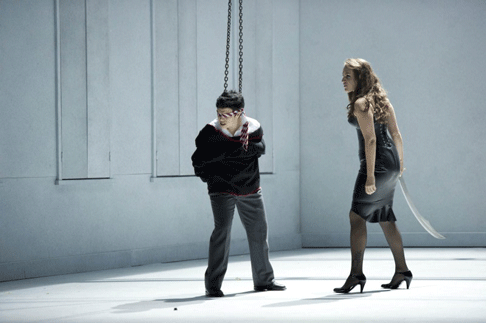 Sonia Prina as Rinaldo and Brenda Rae as Armida
Sonia Prina as Rinaldo and Brenda Rae as Armida
Argante can be a relatively small part, but Luca Pisaroni made it central, by the sheer force of personality in his singing. His voice has great depth and range and is used intelligently. Pisaroni understands the purpose of the elaborate ornamentations Handel wants in the part. When he sings “Sibillar gli angui d’Aletto”, his variations are richly roccoco, emphasizing Argante’s status as ruler, and the complexity of his character. Thus, when Argante is humbled by his feelings for Almirena, Pisaroni’s voice becomes gracious and tender. Pisaroni doesn’t sing when he’s strung up by Armida, but his body language conveys feeling, twitching with anguish, even though his face is hidden. Restored, he becomes the virile, dignified leader he was before, as Pisaroni’s firm, well modulated singing in the Act 3 duet demonstrates. This Argante is more than a match for Armida. (Please read the interview he gave Opera Today here).
Varduhi Abrahamyan sang Goffredo. Being an admirer of countertenors, I was delighted by William Tower’s Mago and Tim Mead’s Eustazio.
Perhaps there’s a much better production inside this Glyndebourne Rinaldo, waiting, like the eponymous hero, to be set free. Handel’s music is inherently dramatic, so the concert performance planned for the BBC Proms on 25th August will be a much better opportunity to appreciate this production. It’s being broadcast live, online, on demand and internationally. A DVD is also planned, and the filming may reshape the staging so it comes over more effectively, enhancing the musical values oif this production.
For more information, read the Glyndebourne Festival site and the BBC Proms site.
Anne Ozorio
image=http://www.operatoday.com/300cbc201106270950.gif image_description=Brenda Rae as Armida and Luca Pisaroni as Argante. [Photo by Bill Cooper courtesy of Glyndebourne Festival 2011] product=yes product_title=G F Handel: Rinaldo product_by=Rinaldo: Sonia Prina, Goffredo: Varduhi Abrahamyan, Eustazio: Tim Mead, Almirena: Anett Fritsch/Miriam Khalil (9th July), Armida: Brenda Rae, Argante: Luca Pisaroni., Mago: William Towers, Conductor: Ottavio Dantone, Orchestra of the Age of Enlightenment. Director: Robert Carsen, Designer: Gideon Davey, Lighting: Peter Van Praet, Movement: Philipe Girardeau, Dramaturg: Ian Burton. Glyndebourne Festival, Lewes, Sussex. product_id=Above: Brenda Rae as Armida and Luca Pisaroni as Argante.All photos by Bill Cooper courtesy of Glyndebourne Festival 2011.
July 12, 2011
Grant Park Music Festival, Chicago Commemorates Gustav Mahler
The work by Mahler was preceded, fittingly, by the Musique funèbre of Witold Lutoslawski, which had originally been composed for the anniversary of Bartok’s death and first performed in 1958. In its performance of the latter work written for string orchestra the Grant Park Orchestra under Kalmar gave a seamless account of the score. The somber introduction for cellos is followed by the gradual introduction of other string groups. A foremost impression left by these performances is the sense of symmetry in Lutoslawski’s “memorial tribute” as the cello ensemble returns to close the piece in an audible mirror of its opening. The four parts of the work entitled Introduction, Metamorphoses, Apogee, Epilogue draw on varying sound palettes for individual and groups of sting players. After the cellos are joined by the remaining strings, tempos increase and allow for declarative statements performed forte. This technique used in the two middle segments of the piece is varied by sections played piano, where the basses used gentle bowing to touching effect. In much the same way, fragments of melodies were played by individual groups, the full melodies then growing into a perceptible unit as tempos accelerated forcefully. A lush, neo-Romantic transition formed the bridge to the conclusion, or Epilogue, as Kalmar led his players toward a dignified statement of tribute with the individual strings dissolving into the inexorable return of the cellos.
The performance of Mahler’s Das Lied von der Erde followed this memorial piece without intermission. In the first of the six vocal parts, “Das Trinklied vom Jammer der Erde” (“Drinking Song of Earth’s Misery”), Mr. Elsner sang with lyrical and dramatic force from the start, as he gave appropriate intonation to the word “klingen” (“resound”). In the delineation of the “Lied vom Kummer” (“song of care”) Elsner’s emotional line was matched by the distinctive solo for oboe. Decoration was taken here as marked with the tenor’s melisma sung on “Fülle” (“abundance”), so that the word as performed reflected its meaning. Starting at this point the English horn solo in this performance lent a complementary sense of melancholy to both the voice and recurrent notes of the oboe. The concept of eternity, which recurs memorably in the final part of Das Lied, is here broached, as the tenor contrasts duration and mortality in “Firmament” and “Der Mensch” (“the heavens,” “You, o mortal”). Here Elsner’s pitch was less distinctive, as the attack on “Mondschein” (“moonlight”) and “Gräbern” (“graves”) was sung with greater force than suitable.
The second song, “Der einsame im Herbst” (“The Solitary one in Autumn”), introduced the performance of Alexandra Petersamer. From the start, the security of the singer’s range assured poignant delivery of lines such as “Vom Reif bezogen stehen alle Gräser” (“The blades of grass stand covered with frost”). Here Petersamer’s voice rose from stirring low notes to a bright top with focus on “Gräser” and, with parallel approach at the close of the strophe, on “ausgestreut” (“scattered about”). When Petersamer began the penultimate strophe in this brief segment, she sang the line “Mein Herz ist müde” (“My heart is weary”) with the pitch toward flat as an illustration of this emotional state. In “Ich hab’ Erquickung not!” (“I need refreshment!”) she engaged in what approached a dialogue with the low strings. As a final statement of yearning “Sonne der Liebe” (“Sun of love”) was delivered by Petersamer with full and convincingly emotional declaration.
In the two vocal parts at the center of Das Lied both singers and orchestra responded to the challenges of tempo in their accomplished performances. In “Von der Jugend” (“On Youth”) Elsner showed skillful modulation as he wrapped the vocal line around accelerated playing. Just as Kalmar’s masterful direction eased the orchestra’s pace at “Wunderlich im Spiegelbilde” (“Wonderfully in the reflection”), the singer’s voice showed a matching deceleration, only to conclude this song by reversing the technique. In her medial song, “Von der Schönheit” (“On Beauty”), Petersamer was equally impressive as her voice imitated the “caressing gestures” of “Schmeichelkosen” as well as the sounds of youths riding their steeds through branches along the river’s bank. In her approach to the last strophe of this segment she used exquisite lyrical phrasing and piano shading to communicate the yearning of the fairest maiden looking after the youth as he galloped away. With tasteful decoration placed on “Sehnsucht” (“longing”) and “ihres Herzens” (“of her heart”) a secret melancholy brought the segment to its moving conclusion.
In his last selection, “Der Trunkene im Frühling” (“The drunkard in Spring”), Elsner contrasted the emotional opposites of toil and torment with the happy “cheerful day” (“lieben Tag”). After sorting through issues of volume in the initial strophe Elsner came into his own at the line “Mir ist als wie im Traum” (“It seems to me like a dream”). At the words “schwarzen Firmament (“dark heavens”) and “betrunken sein” (“remain drunk”) Elsner released powerful forte notes directly on pitch to emphasize his persona’s resolve.
As the final and longest of the six parts of Das Lied Petersamer sang “Der Abschied” (“Farewell”) with touching clarity of tone. After the orchestral opening during which oboe, English horn and flute hint at departure, Petersamer’s singing merged with the instrumental soloists to echo and to enhance their mood. Her pure, high notes on “nieder” (“downward”) and “Schatten” (“shadows”) emphasized the words’ true meanings by contrast of vocal line. The ghostly pitches applied to “Hinter den dunkeln Fichten!” (“Behind the dark pines!”) evoked an evening’s solitude in nature coupled with a desire for companionship. While delineating the atmosphere in the forest her lowest notes were fully audible as the orchestral texture mimicked the sounds of birds. At this point Petersamer’s diminuendo on “hocken still” (“crouch silently”) effectively capped the emotive setting in nature. As her declarations on beauty echoed earlier sentiments, an orchestral interlude extended the atmosphere with notable contributions from the woodwinds and low strings. Petersamer’s singing concluded the piece as the “Trunk des Abschieds” (“Cup of Farewell”) began the future thematic wandering of the departing friend. The singer’s elaborate, meaningful decoration executed on “einsam Herz” (“solitary heart”) illustrated along with the concluding intonations on the repeated “ewig” (“eternally”) that this was a performance of Das Lied von der Erde in which text and music are ideally joined, where poetry and song receive their due when performed with such significance.
Salvatore Calomino
image=http://www.operatoday.com/gustav_mahler.png
image_description=Gustav Mahler
product=yes
product_title=Gustav Mahler: Das Lied von der Erde; Witold Lutosławski: Musique Funebre
product_by=Grant Park Orchestra. Carlos Kalmar, Conductor. Alexandra Petersamer, Mezzo-Soprano. Christian Elsner, Tenor.
product_id=Above: Gustav Mahler
La rondine, Opera Holland Park
Last time OHP staged La rondine it still fell into this category, and until that year, there had been no London staging of the piece for decades. But the gorgeous, star-studded EMI recording of 1996 had revived interest in the piece, and in 2002 the Royal Opera (with the Magda and Ruggero of the EMI set, Angela Gheorghiu and Roberto Alagna) mounted its first-ever Rondine, pipping OHP to the post by a matter of weeks. Despite the fact that the ROH production must have been in the pipeline for a while, the timing seemed almost impolite.
At every turn of La rondine there is a reminder of Puccini’s earlier work; the pentatonicism of Butterfly, the dreamy end-of-act exits of Bohème (La rondine goes so far as to end every act with one), the bustling ensembles of Manon Lescaut. And the tenor aria in the middle of Act 1, ‘Parigi’, sounds like an afterthought inspired by ‘Firenze’ from the later Gianni Schicchi — which, of course, is exactly what it is, having not been part of the original score. But somehow La rondine still manages to be unique among Puccini’s output, a drama with comic episodes that has a flavour all of its own.
Nine years after that pair of London stagings, this lovely piece has managed to maintain... well, perhaps not a firm foothold in the repertoire, but certainly a presence. There has been a revival of the Covent Garden production, and a staging by British Youth Opera. Now it is back at Holland Park in a brand-new staging, no longer one of the season’s novelty pieces but a tried and tested crowd-pleaser. It says much in its favour that the entire run is sold out.
Tom Hawkes’s production updates the action to around the time of the opera’s composition — it premiered in 1917, under the shadow of World War 1. Designer Peter Rice transforms the stage with an elegant arc of Rennie Mackintosh-inspired metalwork which acts as the uniting factor for all three scenes of the opera. Each act has its own colour scheme; Magda’s chic soirée is mostly muted pastels and silver, while much of the clientèle of Bullier’s bar is edgy monochrome with bold-coloured accents. Both of these situations provide a backdrop for Magda to stand out from the crowd in a contrasting palette of colours — her almost regal gown of crimson velvet gives way to a simple blue dress for her night out. Truth be told, this misfired somewhat — my first thought was of Tosca disguising herself as Micaela from Carmen! - but the point became clear in Act 3 when everything, including Magda, was in white. It is made very clear that until Ruggero inadvertently rocks the boat by proposing marriage, this is where Magda finds a sense of comfort and belonging.
As Magda (the ‘swallow’ of the title), the Australian soprano Kate Ladner was glamorous, feminine and self-assured — she would have been a head-turner even without the stand-out costumes. Her poised and voluptuous soprano was perfect for ‘Chi il bel sogno di Doretta’, the small-talk of Act 1 and the intimate duet scenes. She was well-matched by Seán Ruane as Ruggero, convincingly youthful and with a refreshing tenderness to his tone. The one thing both initially lacked was abandon — both Magda’s outburst of longing for romantic adventure at the end of her second aria and the lovers’ cries of ‘Dolcezza! Ebrezza! Incanto! Sogno!’ in the middle of the Act 2 waltz sounded far too safe. Happily, they found the extra reserve of expansive lyricism in time for the impassioned heart-searching of Act 3.
Hal Cazalet’s light tenor was ideal for Prunier the poet; as the salon raconteur of Act 1 his gift for natural and conversational delivery of sung dialogue really came into its own. He and Hye Youn Lee’s good-natured, vivacious Lisette made a natural and likeable couple.
The group scenes really felt relaxed and natural thanks to the detailed direction of an array of contrasting and credible characters, and a classy ensemble comprised mainly of OHP regulars. Stephanie Bodsworth, Sarah Minns and Olivia Ray were as lively, sparkling and characterful as the three grisettes in Act 2 as they had been as Magda’s guests in Act 1. Nicholas Todorovic (Kate Ladner’s real-life husband) was a gruff, proud Rambaldo, and there was a very impressive turn from the young soprano Anna Patalong as the unnamed voice whose mysterious solo at the end of Act 2 warns of the fickleness of love. The OHP chorus, too, were on fine form.
In the pit, Peter Selwyn and the City of London Sinfonia succeeded in capturing the delicate colours of the score — Viennese melodic sentiment couched in a rich, Italianate and recognisably Puccinian idiom. At times I felt Selwyn could have been a little more attentive to the singers (at one point in Magda’s second aria, Ladner had to make an adjustment for having been left behind by the accompaniment) but it was a pleasure to listen to, always well-balanced.
For rarity value, go and see La Wally later this month. For high drama, catch Rigoletto. But for melody, elegance, lovely singing and fine ensemble work, this Rondine has all that Holland Park is best at, and all I could have asked of it.
Ruth Elleson © 2011
image=http://www.operatoday.com/La_rondine_OHP.gif image_description=La rondine [image courtesy of Opera Holland Park] product=yes product_title=Giacomo Puccini: La rondine product_by=Magda: Kate Ladner; Ruggero: Seán Ruane; Lisette: Hye Youn Lee; Prunier: Hal Cazalet; Rambaldo: Nicholas Todorovic; Perichaud: Henry Grant Kerswell; Crebillion/Rabonier: Maciek O’Shea; Gobin: Patrick Mundy; Bianca/Gabriela: Sarah Minns; Suzy/Lolette: Olivia Ray; Yvette/Georgette: Stephanie Bodsworth; Una voce interno: Anna Patalong; Il Maggiordomo: Geoffrey Thompson. Opera Holland Park Chorus. City of London Sinfonia. Conductor: Peter Selwyn. Director: Tom Hawkes. . Designer: Peter Rice. Lighting Designer: Colin Grenfell. Choreographer: Jenny Weston. Opera Holland Park, July 2011. product_id=Above: La rondine [image courtesy of Opera Holland Park]Cendrillon, Royal Opera
This is the starting point for Laurent Pelly’s vision of the Cinderella story — this, and the substantial faithfulness with which Massenet’s opera adheres to the original Perrault fairytale. The opening tableau is the opening pages of the Perrault, enlarged to wall-size; a small room soon grows into a bigger room, and a bigger room still. Soon, words are everywhere. As Lucette — the eponymous Cendrillon — falls sadly asleep in the middle of the first act, the stars come out — pin-pricks in the text on the wall, just where the dot of every ‘i’ should be. Next, ten or so Lucette-clones appear with lamps in their hands, as if making the stars dance, and thus the text begins to come literally to life.
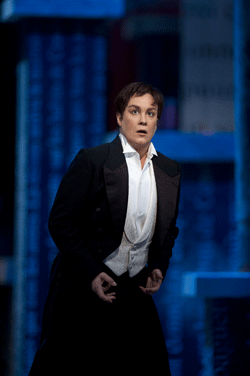 Alice Coote as Le Prince Charmant
Alice Coote as Le Prince Charmant
The clones turn out to be the pet spirits of Lucette’s Fairy Godmother, who get sent off to prepare Cendrillon’s gown and carriage and horses. Of course it is handy having ten singers and dancers running round the stage who look exactly like the heroine — an eminently practical way of ensuring that the real Cinders can be smuggled off unnoticed for her quick change.
The word-theme continues throughout, with Cendrillon’s carriage being made of the letters of the word “Carosse” (drawn by four dancers dressed as horses) and the giant golden gates of the palace being formed of the letters of the phrase “Les portes du palais”. Some would think this slavish, but I simply got a strong and comforting sense that Pelly has a real, affectionate love for this children’s tale.
The princesses at the ball were a grotesque array of cartoonish ladies in red, all with exaggerated shapes and figures (none more so than Cendrillon’s unpleasant stepmother and sisters, the former resplendent in what looked more like a piece of amply-upholstered furniture than a dress) and many looking like Grecian urns or elaborate topiary. If I hadn’t known that the production dates back to 2006 (in Santa Fe) I would have thought them a reference to the Queen of Hearts in the Royal Ballet’s recent Alice’s Adventures in Wonderland. Cendrillon is, after all, one of the few French 19th-century operas where a ballet scene fits nicely into the story without having to have an opportunity created for its existence, and it is telling that as I left the opera house at the end of the evening, I had strains of various divertissements from The Nutcracker floating through my mind along with snippets of Massenet.
If the visual inventiveness lapses in the early part of Act 3, all is restored in the curious ‘Fairy Oak’ scene (an invention of Massenet and his librettist) in which the stage is transformed into a rooftop scene (chimneys replacing the forest trees of the stage directions) which at first conjured up the chimney-sweep scene from Mary Poppins. But later a more apt comparison occurred to me; it’s the sort of scene generally seen from the garret window in La boheme. This is more relevant than you might think, as despite the supposedly fantastical context, it becomes one of the opera’s most genuinely human scenes, climaxing in a rapturous love duet in which the Prince’s voice joins Lucette’s in glorious unison before parting into harmony.
It was in this duet, and to a lesser extent their other scenes together, that the two stunning mezzo leads were showcased to best effect. The voices worked wonderfully well together — Joyce DiDonato’s tone sweet and soprano-like in the title role, and Alice Coote’s velvety, plush shades as an ardent Prince Charming. Individually of course they were just as good. Coote has plenty of experience in trouser roles, and not merely because of her voice type — her credibility as a hot-blooded youth is impeccable, evidently the result of meticulous observation. Meanwhile, DiDonato had a handful of high pianissimi which didn’t quite come off, despite the fact that the high-lying role generally seems to sit very comfortably in her voice, but she was a delightful heroine, making much of the understated, attractive music Massenet gives her.
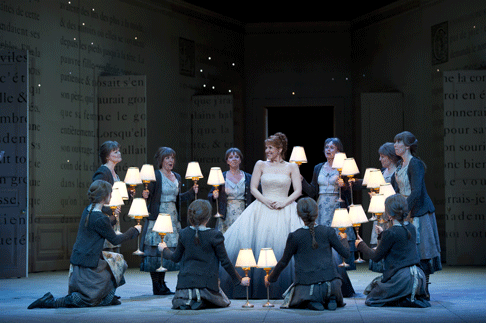 Joyce DiDonato as Cendrillon
Joyce DiDonato as Cendrillon
DiDonato was equally touching in the scenes with her father, Pandolfe, sung by the French bass-baritone Jean-Philippe Lafont. Lafont makes much of the character, but his voice is evidently far beyond its peak, grating and wobbly.
In less distinguished company, the great Polish contralto Ewa Podleś as Madame de la Haltière would have walked away with the entire show. Her lower register remains earth-shaking, but more to the point, she understands the critical importance of playing farce straight. Her final declamation of ‘Ma fille!’ — when she finally sees fit to acknowledge Lucette as a daughter — brought the house down.
Pelly generously makes this latter-day change of heart a result of an intervention by the Fairy, rather than a cynical acknowledgement ot Lucette’s sudden acquisition of status and glamour. And what an accomplished Fairy we had in the Cuban-American soprano Eglise Gutiérrez. She is confident and ravishing in spinning high lines, and her trill is so impressive that I will forgive her the occasional intonation lapse in staccato coloratura. Her poised and alluring stage presence put me in mind of Tytania from Britten’s Dream; she was given a bit of an edge with a modern, spiky hairdo, and I wouldn’t have been surprised to see a pair of customised Doc Marten boots under her lavish silver-grey ballgown.
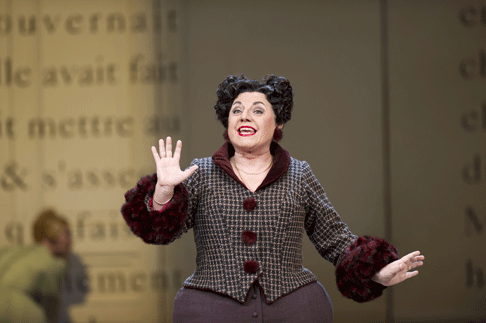 Ewa Podleś as Madame De La Haltière
Ewa Podleś as Madame De La Haltière
ROH Young Artists Madeleine Pierard and Kai Rüütel were well-matched as the two stepsisters, Noémie and Dorothée; in the first scene (in which, incidentally, they appeared to be dressed as pastel-coloured lampshades) their diction was indistinct, but this improved as the evening went on.
Bertrand de Billy’s conducting, a couple of lapses in ensemble aside, had energy and sensitivity. But the Fairy clearly thinks she can do a better; atop a giant pile of books, like a Valkyrie calling from a mountain-top, she hijacks the task of conducting the final few bars to make quite, quite sure of her happy ending.
Ruth Elleson © 2011
image=http://www.operatoday.com/CENDRILLON.201107020188.gif image_description=(Back to front) Eglise Gutiérrez As La Fée and Joyce DiDonato as Cendrillon [Photo by Bill Cooper courtesy of The Royal Opera] product=yes product_title=Jules Massenet: Cendrillon product_by=Pandolfe: Jean-Philippe Lafont: Madame de la Haltière: Ewa Podleś: Noémie: Madeleine Pierard: Dorothée: Kai Rüütel: Lucette (Cendrillon): Joyce DiDonato: La Fée: Eglise Gutiérrez: Le Surintendant des Plaisirs: Dawid Kimberg: Le Doyen de la Faculté: Harry Nicoll: Le Premier Ministre: John-Owen Miley-Read: Le Prince Charmant: Alice Coote: Le Roi: Jeremy White: Six spirits: Kristy Swift, Katy Batho, Yvonne Barclay, Tamsin Coombs, Louise Armit, Andrea Hazell: Le Hérault: Adrien Mastrosimone. Royal Opera Chorus. Orchestra of the Royal Opera House, Covent Garden. Conductor: Bertrand de Billy. Director: Laurent Pelly. Set designer: Barbara de Limburg. Costume designer: Laurent Pelly. Associate costume designer: Jean-Jacques Delmotte. Lighting designer: Duane Schuler. Choreographer: Laura Scozzi. Revival choreographer: Karine Girard. Royal Opera House, Covent Garden, July 2011. product_id=Above: (Back to front) Eglise Gutiérrez As La Fée and Joyce DiDonato as CendrillonAll photos by Bill Cooper courtesy of The Royal Opera
Guillaume Tell, Caramoor Festival
One such festival is the Caramoor Music Festival of Katonah, New York with its dedication to bel canto repertoire for its opera portion. It is true that since its resurgence after World War II, at the hands of Joan Sutherland and Maria Callas, bel canto opera is now firmly ensconced in the repertoire. But do not be fooled. As Will Crutchfield, the festival’s conductor, has previously stated, the goal of the festival is to present the lesser known bel canto operas. To that end, the festival is formatted such that one staple shares the stage with a more obscure work. Last year, Donizetti’s evergreen, drunken revelry L’elisir D’Amore was paired with Rossini’s majestic Semiramide.
This year, eyebrows were raised when Caramoor presented Rossini’s seldom heard epic Guillaume Tell alongside Gilbert and Sullivan’s operetta HMS Pinafore. True, HMS Pinafore does not belong to the group of operas that we recognize as bel canto. Yet, according to an article in the New York Times by Allan Kozinn, audiences fail to realize that Arthur Sullivan held a job as a copyist in which he created reductions of bel canto opera. As a consequence, he was well acquainted with stylistic conventions, and his operettas can be seen as having evolved from that tradition. Furthermore, Patrick Dillon, a writer for Opera News argues that Guillaume Tell while a bel canto opera in the strictest sense had far reaching effects in the creation and standardization of French Grand Opera that lasted until the composition of Verdi’s Don Carlo. In this way, the theme of this Caramoor season seems to be the long lasting legacy of bel canto opera.
Regarding Guillaume Tell, I have nothing but good news to report. It was one of those performances of which opera lovers dream. Under the direction of the eminent Mr. Will Crutchfield, the orchestra of St. Luke’s demonstrated all the drama and complexities of Rossini’s vast score.
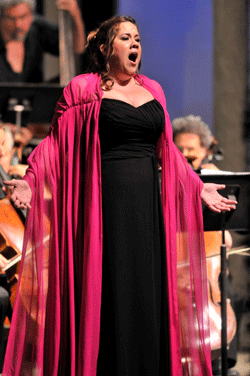 Julianna Di Giacomo as Mathilde
Julianna Di Giacomo as Mathilde
To comment on their dynamics and flare for theatricality would be obvious; I was most impressed with the dialogue between instrumental sections. If this were one of Rossini’s Italian comedies such as L’Italiana in Algeri, the opera would be full of ensembles in which the vocals lines would similarly interact with each other. Here, however, I was impressed with Rossini’s ability to transpose his skill for ensemble writing to the orchestra itself. Additionally, the strings brought a mellow burnished quality to the music; presenting a beautiful cohesive tone in a score with a plethora of strings.
The cast was in excellent form. Bass-baritone Daniel Mobbs, who sang the role of Tell, gave a thrilling dynamic portrayal. He managed to cover all facets of the character from revolutionary leader to husband and father while singing with style and spell-binding tone. Much the same can be said of Mezzo Vanessa Cariddi. Although, early on, her dramatic commitment to the role was less apparent, it came beautifully into focus with the last act. However, it is quite plausible that the reason for her character’s lack of substance lies within the opera itself. Tenor Michael Spyres, in the role of Arnold, sang with conviction and made his character a convincing case for the beloved operatic trope of tenor-as-lover. He also sang the role’s astronomically high tessitura with ease. Still two aspects of his performance should be mentioned. Vocally, he seemed to get lost in passages of either high powered orchestral work, or in ensembles. Additionally, he needs to develop a better physical and emotional connection with the other characters. Soprano Julianna Di Giacomo was incredibly compelling in the smaller but crucial role of Mathilde. Her deeply lyrical soprano was a joy to behold. Her voice brought much appreciated texture to the trio of Act IV with Mathilde, Tell’s wife Hedwige, and Tell’s son Jemmy. Soprano Talise Trevigne was delightfully boyish as Jemmy, while Scott Bearden was ferocious as Switerland’s Hapsburg governor.
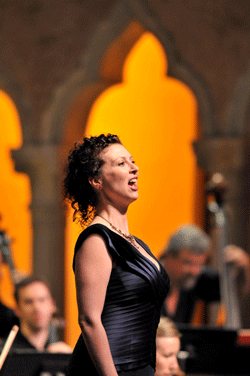 Vanessa Cariddi as Hedwige
Vanessa Cariddi as Hedwige
The Caramoor festival chorus was in full vocal throttle when they joined the rest of the cast during the many ensembles. I could not help but smile at Rossini’s overt attempts to incorporate the tastes of the Paris Opera.
It remains to be said that Caramoor is a beautiful setting. When an obscure opera like Guillaume Tell is performed in such grand style and the audience is treated to fresh air, and exquisitely perfumed gardens, the question becomes, why isn’t this opera performed more often? My guess would be size and expense. It is true that massive forces are required to perform the work, and that according to Patrick Dillon of Opera News, the opera has never been performed in its complete version in the U.S. Yet despite the opera’s marathon four hours, this is an engrossing opera permitting time to pass quickly. Therefore, I have to say that I would gladly see Guillaume Tell again. And after all, isn’t that the goal of bel canto at Caramoor?
Gregory Moomjy
image=http://www.operatoday.com/20110709Caramoor_9556.gif image_description=Daniel Mobbs as Guillaume Tell and Talise Trevigne as Jemmy [Photo by Gabe Palacio courtesy of Caramoor Festival 2011] product=yes product_title=Gioachino Rossini: Guillaume Tell product_by=Guillaume Tell: Daniel Mobbs; Mathilde: Julianna Di Giacomo; Arnold: Michael Spyres; Jemmy: Talise Trevigne; Hedwige: Vanessa Cariddi; Walter: Nicholas Masters; Rodolphe: Rolando Sanz; Fisherman: Brian Downen; Melchtal: Jeffrey Beruan; Gesler: Scott Bearden. product_id=Above: Daniel Mobbs as Guillaume Tell and Talise Trevigne as JemmyAll photos by Gabe Palacio courtesy of Caramoor Festival 2011
Raffaele Cardone, Miami Lyric Opera
Town after town of opera talk on the streets, remember? Neither do I, but Raffaele Cardone does. The pioneer and director of Miami Lyric Opera (MLO) hails from an operatic place and time that once was, and he wants to give you a taste.
Life and music were interwoven for the child growing up in the picturesque seaside village of Bari in southern Italy (on the Achilles of the boot) in the 1940’s. For Cardone, as it was for many children throughout Italy, the church formed yet another plait in the fabric of a life. Cardone was, “six, seven year old, already learning the sacred music and all this way of singing.” “Then, as a teenager, I entered into conservatory to study music and violin and theory”… “and, of course I was singing always. I was singing in the churches and I was singing in small festivals.” For Raffaele Cardone, an operatic fortune was born at the age of 13 when he began voice lessons.
At the “school of the opera Alla Scala” (now most analogous to the Accademia Teatro Alla Scala) students received rigorous training and immersion into the world of opera. Cardone benefitted from, “repertoire teachers and constant repeititoro, repassatorio or coaches as you call here, no? The concept of coaching [is] completely different what is here and what is there.” “Even now, to be a coach you have to know opera very well, or you have to be a singer.”
Cardone’s star met with opportunity when he sang for Bruno Landi, a tenor that enjoyed an international career. Just like that, Cardone was off to Argentina with a touring group. From then on, Cardone’s life through music sent him trip-hopping through South America and much of Eastern Europe, back to Italy for more study, then to Mexico, Central America and the southern United States.
In Argentina at the Teatro El Circulo in Rosario, Cardone‘s first stint in a principal role came as the Duke in Rigoletto. In Geneva, he replaced the Rodolfo — the tenor contracted for that series of Bohemes was a performer whose name you might have heard, Giuseppe Di Stefano. In Chicago, with the Lyric Opera, he prepared to come in as the Duke for another tenor whose name is known to operaphiles, Alfredo Kraus. In Mexico, Cardone remembers that the capital city’s adopted first musical family took interest in him even while their Placido was cutting his teeth in secondary roles. “They [the Domingos] came to all my [operas].”
Other names that come up in opera conversation with Cardone, persons directly in his orbit as he embarked on a singing career, include Carlo Tagliabue (Cardone’s voice teacher and promoter) and Gianni Raimondi (Cardone covered for the tenor extensively; later the two became personal friends). Other theaters that figured in the making of Cardone’s career include El Palacio De Bellas Artes in Mexico City (where he performed for three seasons in the 1970’s and from whence an extensive concert career was propelled) and the Brooklyn Academy of Music (in the 60’s, BAM was a springboard to the Metropolitan and the company of Cardone’s American debut).
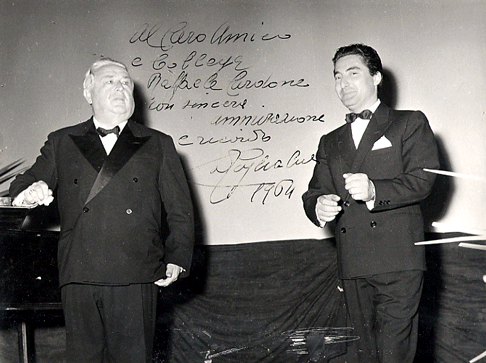 Carlo Tagliabue and Cardone in recital [Photo from Raffaele Cardone’s personal collection]
Carlo Tagliabue and Cardone in recital [Photo from Raffaele Cardone’s personal collection]
In short order, after some health issues in the early 80’s, Cardone turned to consulting and training aspiring singers in master classes and private lessons. His final performance in opera was a heady one: in 1982 as Arturo in Puritani at Bellas Artes in Mexico with Antonio Almeida — a protégé of Leonard Bernstein’s — leading.
It was matters concerning Cardone’s health that first landed him in Miami — the city grew on him and his wife; they decided to make the Magic City home in 2002. With Miami as a base, Cardone reconnected with former students, and he steadily picked up local students and a reputation. He caught on early that south Florida could seem like a black hole for classically trained singers. Noticing that promising singers were falling through the cracks, the idea driving Miami Lyric Opera hatched with Cardone’s question: after developing a technique, “what are they [the singers] going to do now?”
Miami Lyric Opera was the answer to that question. What started with a few singers and a piano blossomed into fully staged operas, with a standing chorus and orchestra of over twenty and, “hundreds of young, of new singers coming through the mills,” Cardone beams. Cardone adds that MLO now serves as a repository of talent for the area and for the regional company, Florida Grand Opera. In the face of financial straits encountered in the arts today, the advantages of this are palpable — FGO has begun to engage performers that have appeared with MLO, significantly reducing costs and nurturing local talent.
Cardone counts 70 performances put on by MLO to date. The most recent of these was a Rigoletto in late June that confirms the company has reached important developmental milestones: better designed sets germane to the specific opera staged, invested stage direction, and greatly improved playing in the pit. The pacing of that Rigoletto goes along especially well with the sentiment of “times that once were.”
In 2007, the cranking, clanking and organ-grinding effort and motion of a MLO Boheme brought to mind the band behind Caruso, the first international recording artist singing into a cone in those turn-of-the-century recordings. Enter a few instrumentalists from established south Florida groups (including FGO), increased rehearsal time, and stable leadership and in 2011 it is in the music where MLO’s progress is most evident. While Maestro Doris Lang Kosloff managed to hold together a Rigoletto of improbably leisurely tempi, few were the moments when the playing sounded shrill, exceedingly uneven, or “historic.”
Leisurely is the apt term for the cadence of passers-by on Lincoln Road in Miami Beach, the site of MLO’s performance home Colony Theater — as iconic a Miami spot as any other. If not slumber, surely strolling is celebrated here and you would be hard-pressed to find a more intimate setting to celebrate opera. Lincoln Road is modeled after the European walkway mall — coffee rooms, shops, and ethnic eateries offering outdoor dining under umbrellas dot its block-after-block expanse. On the east side is the much ballyhooed new home of the New World School of the Arts. On the west side, some six blocks down, is Colony Theater.
Its marquee is old-time movie house, everywhere else the space is pure Art Deco — the Colony channels the 1930’s, when it was erected by Paramount Pictures as part of a nationwide campaign to promote its films. The Colony was recently retrofitted for stage performances. MLO’s orchestra pitches its music stands on the landing between the first row of seats and the stage in the 440 seat space. The sound is variable and the visuals are consistent, both decent for a venue made for film viewing. The breeze, the beach, the beat, opera at the Colony all channel a period all but lost now.
One gets the sense that something important is at work in spending time with Raffaele Cardone. Time stands still — opera history is preserved, its traditions transmitted. Time stands still — we participate in telling a story in opera, giving it new life, extending its life. Is this “time that once was” lost for good? Not if Cardone has any say, not if you’ll come get a taste. If you do, come to it remembering that in order to truly taste something, to savor its goodness, it must be relished with ease so that its layers and dimensions get their due. Come slow things down, but do come. Come get a taste of a time that once was with Miami Lyric Opera.
Robert Carreras
For more information, go to www.miamilyricopera.org
Check the Colony Theater out at www.colonyandbyrontheaters.com
image=http://www.operatoday.com/Cardone5.gif Image_description=Miami Lyric Opera’s Raffaele Cardone [Photo by R. Carreras] product=yes product_title=Raffaele Cardone, Miami Lyric Opera product_by=By Robert Carreras product_id=Above: Miami Lyric Opera’s Raffaele Cardone [Photo by R. Carreras]“Opera is like a tree” — ZhengZhong Zhou
Such is the status of the Young Artists Programme that it attracts hundreds of applicants for the dozen or so places offered each year. Talent alone is not enough. Only those with proven professional experience and potential are chosen in the first place. Vocal ability is a given. Over the two year Programme, their skills are refined. They work on vocal improvement, language, stage skills, and personal skills. ZhengZhong Zhou joined the Young Artists Programme in September 2010.
Before he came to London, he spent two years in the company at Marseille Opera, developing an affinity for French repertoire. Before he left France, he sang a recital of Poulenc songs, he recounts. “I love Poulenc”, he says “and Debussy!”
Born in Hubei, China, he trained at the Shanghai Conservatory, established 100 years ago. Shanghai was the biggest city in the world, sophisticated and international. Russian and central European refugees flocked to China, many of them talented musicians and singers. The Shanghai Conservatory was a centre for excellence, even in the dark days of the Cultural Revolution.
Singing came instinctively to Zhou. In 1983, the year before he was born, Luciano Pavarotti gave a concert in Beijing. The recording became so popular in China that it was frequently played on the radio and on cassettes. Everyone listened. Zhou absorbed Pavarotti even before he’d learned to speak. As an infant he was singing along, for the sheer joy of singing, too young to recognize language or style. “I sang ‘O sole mio’”, he say. “People used to say, why is that boy singing in Italian? But I was too young to know the difference. I just sang because I loved it and wanted to sing it all the time. I liked Pavarotti because his voice was so wide and bright, but I copied every different voice type, because it was so much fun”.
“Maybe it helps because Chinese is a musical language”, he says “everything comes from tones, and you change meaning by changing pitch”, he says. “When I meet musicians, I tell them they can remember how to pronounce my name by the tune”. He then sings his name showing how the inflections work. “In Mandarin there are four tones, and in the south there are nine different tones”.
“Music is international, because it’s about feelings, and everyone has feelings”, says Zhou. “in every part of the world. So when you are singing you are not just singing words, you’re singing feelings”. Zhou sings a passage from Don Carlo in a straightforward manner. Then his face lights up and he sings the same passage, this time full of expression.“You add little breaths and make little changes”, he says, “so you can make it sound true”. Then he sings it again explaining phrase by phrase, with great enjoyment..
Zhou brings his notebooks out of his briefcase. “I write out the music by hand. Then I write the words, then I write notes for myself, to show how to shape the singing and meaning”. He makes numerous interpretive markings and uses different coloured inks, so the notes are surprisingly easy to follow. The idea is that, with this thorough groundwork, he can absorb the music intuitively. In performance, he’s then free to sing spontaneously, having built the foundations beforehand.
“I’m so happy to be in Europe because that is the motherland of western opera”, he says. We discuss the wider cultural milieu that is the background to understanding European opera. “I like to learn”, he says, with enthusiasm. Zhou is an avid reader. Recently he sang Brühlmann in Massenet’sWerther. It’s a small part but Zhou is observant. “Massenet is interested in all the family, Albert, Sophie, the children. Family and duty. It’s different to Goethe’s Werther”.
Since Werther, Zheng has created Prince Yamadori in Puccini Madama Butterfly, which has been filmed for cinema release. Yamadori is an interesting character because he has the highest status of anyone in the opera. He rides in a carriage, the others walk. Yet he will give up his other wives to marry Cio Cio San if she’ll have him. It’s a substantial part for a singer still in his mid-twenties, but Zheng made it sympathetic.
On 17th July, the Jette Parker Young Artists Programme holds it year-end gala. The show is put together by the young artists themselves. This year’s theme is “Venice - its history, mystery and glamour. The first part of the programme is built around lesser-known Rossini, and the second part around Donizetti, Offenbach and Britten. Zhou is singing. He speaks animatedly of the pleasures of bel canto.
“We learn to connect to people”, he says of the Jette Parker Scheme. “The singing, of course, but everything else that goes into making opera, like stagecraft and acting.” For his graduate dissertation, Zhou wrote about acting in opera, studying Stanislavski, the Alexander technique and Rolando Villazón as case study. “Opera is like a tree. The roots grow from the music, they are the basic part, but the branches are acting, using language, movement. When the whole tree grows strong, then you can reach people better”.
Zhou mentions a movie about a prison, where the prisoners are brutally treated. Then one of them hears Mozart on the radio. “When he hears Mozart”, says Zhou, “The prisoner thinks, I am human, I am a man, even in that prison. He doesn’t know about classical music, but the music has that effect on him”.
“It is like light. Electric light is easy, you just turn a switch. But opera is like a candle. You light the flame, and it keeps changing colours, shadows, moods. If you want to connect with people, you want the right atmosphere to communicate. Rich or poor, everyone has feelings. So you want to reach those feelings”. What does Zhou do when he’s not working? “I get frustrated”, he says, “I need to sing”.
For more information, please see the Royal Opera House website.
Anne Ozorio
image=http://www.operatoday.com/ZHENGZHONG-ZHOU.gif image_description=ZhengZhong Zhou [Photo courtesy of The Royal Opera House] product=yes product_title=“Opera is like a tree” — ZhengZhong Zhou product_by=By Anne Ozorio product_id=Above: ZhengZhong Zhou [Photo courtesy of The Royal Opera House]July 11, 2011
Maria di Rohan/Saul, Buxton Festival, Derbyshire, UK
By Andrew Clark [Financial Times, 11 July 2011]
Of all the UK’s summer opera venues, Buxton must be the most relaxing and the least pretentious. The town, once a holiday spa for well-to-do Lancashire families, exudes faded elegance and upmarket potential, but its countrified Peak District setting encourages a longer stay. Having had a chequered career over the past 30 years, the festival is on an upward curve. Its greatest asset remains the Opera House, a 900-seat Matcham jewel, and this year it has expanded to three in-house productions, running on consecutive nights - a good package.
Alexandra Deshorties carves indelible image as the wily sorceress in Glimmerglass's 'Medea'
By David Rubin [CNY Café Momus, 10 July 2011]
To open its 2011 season, the Glimmerglass Festival outside Cooperstown, New York offered two French operas with strong (and nasty) women at their centers: Georges Bizet’s chestnut Carmen, and Luigi Cherubini’s rarity Medea. First performed in 1793, Medea has never been very popular. Carmen was clearly meant to sell tickets. Medea was meant to attract attention.
July 10, 2011
Faust Reaches Santa Fe Opera — And How!
It is a mega-show that happily falls into the success column, despite some excesses and an occasional mis-fire. This commentary is based on the second performance, July 6, with eye-watering toxic fumes and particulates still in the air from the forest fires that have been surrounding Santa Fe, forcing the Opera to hire school gymnasia for rehearsals. If circumstances have been hard on the singers and production staff, as they surely have, it is almost miraculous that so complex a show opened on time and in reasonably good order.
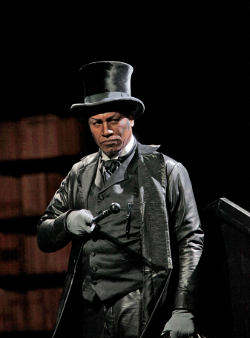 Mark Doss as Méphistophélès
Mark Doss as Méphistophélès
Here is a taste: The cassetta of jewels, directed by the composer to be left by Méphistophélès in Marguerite’s garden to impress the innocent maid as a token of Faust’s affection, was instead a large Tiffany-esque show window, wheeled in from stage right, loaded with glittering jewelry and large enough for Marguerite to enter and make her selection; even her portly duenna, Marthe, wiggled in and grabbed up whatever Marguerite left behind. When it was time for the soldiers’ chorus, they executed a smart drill, wearing long greatcoats and spiked helmets that might have betokened the Franco-Prussian war, and when the bucolic Kermesse (village fair) scene arrived, it was equipped with a Ferris wheel (history’s first was at the Chicago World’s Fair 1893), while the merry singing and dancing took place amidst a carnival midway of gaudy freak shows, with uni-cyclists, stiltists and roller-skating. In fact, Marguerite makes her entrance upon roller skates! No, I did not make that up.
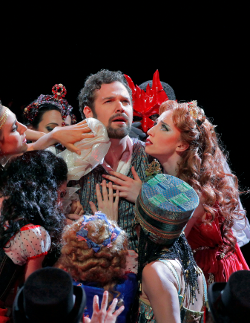 Clockwise from top: Bryan Hymel as Faust, Mark Doss as Méphistophélès, Gabrielle Zucker as Helen of Troy, Kessa Huey as Cleopatra, Kristin Osler as Manon, Heidi Kershaw Carmen, Hallie Brenner Dalsimer as Salome and Jasmine Quinsier as Delilah
Clockwise from top: Bryan Hymel as Faust, Mark Doss as Méphistophélès, Gabrielle Zucker as Helen of Troy, Kessa Huey as Cleopatra, Kristin Osler as Manon, Heidi Kershaw Carmen, Hallie Brenner Dalsimer as Salome and Jasmine Quinsier as Delilah
Action was constant, and with much busy detail, and if it was anachronistic, well never mind! One had to chuckle that Marguerite, as she sang the ballad of the King of Thulé, avidly worked at her humming Singer sewing machine rather than the traditional spinning wheel. The production continued in such style for much of the evening. It must have been exhausting and expensive to mount. While there were small moments that needed tightening or fine-tuning, I expect by the full repertory run in August all will be well polished to the satisfaction of those seeking gaudy entertainment, even if the first three acts were combined into a 90-minute Marathon before the single intermission.
Frédéric Chaslin, the French conductor, pianist and composer, in his second year as principal conductor at Santa Fe, proved the musical jewel of the evening. His orchestra was alert, accurate and highly responsive to his direction. He did linger now and then with a slow tempo, but the waltz scene and later the rarely played ballet of courtesans, ticked along crisply and with élan. I hope we hear a lot of Chaslin in his native opera repertory. He’s the real thing! And how very pleasant to hear French opera with a Frenchman in the pit. Bravo!
Santa Fe has always been a company that seemed to spend more on production values than on vocal talent, but that alone cannot account for a certain mediocrity that beset the singing cast, with one exception: Ailyn Pérez in a strongly sung musically solid performance of Marguerite, the star of the show. Her French pronunciation had its Hispanic moments, but the free flow of tone, her ease in the top soprano register, and her energy and ability to enter into hyper-action staging won deserved applause. Basso Mark Doss, senior member of the cast appropriately appearing as Méphistophélès, was totally into his role, aided by experience and purpose in his portrayal; vocally, he was underpowered and was too often unheard over the orchestra. I would have rather heard him as Leporello in the Mozart opera.
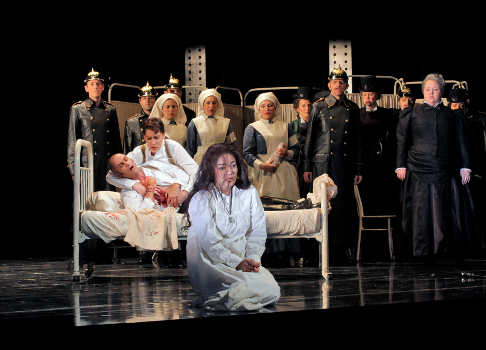 Background left: Matthew Worth as Valentin, Jennifer Holloway as Siébel and Chorus, Foreground: Ailyn Pérez as Marguerite
Background left: Matthew Worth as Valentin, Jennifer Holloway as Siébel and Chorus, Foreground: Ailyn Pérez as Marguerite
Tenor Mark Hymel had the high-lying phrases for his demanding title role and gave pleasure with his well achieved high tones, even if his bright tenor was a bit lacking in body and seemed nonexistent in the lower register. Few tenors today are reliable in this classic tenor role once graced by the likes of Jean de Reszke and Jussi Bjoerling (they don’t make ‘em like that any more). A young lyric baritone, Matthew Worth, qualified as a French bariton martin, with a pleasant light voice suited to such as Pelléas or Massenet’s Juggler, Jean. Worth was not equipped with the kind of burly vocal weight needed to make Valentine credible. He played the part well and was touching in his scenes with Marguerite.
In smaller but important roles, Jennifer Holloway was effective as Marguerite’s teenage suitor Siebel, here given two arias rather than only the usual Flower Song, while the greedy duenna Marthe was ably presented by mezzo Jamie Barton, though Faust’s wine-loving friend Wagner, was only faintly heard as sung by another too-light baritone, Darik Knutsen. The 2200-seat Santa Fe house is a kind host to larger voices that project well – such are much needed.
The antic stage direction was by the noted Stephen Lawless aided by Belgian scenic designer Benoit Dugardyn, who made good use of the full stage and whose work was colorful and pungent, even if it did consist mainly of props. It all worked!
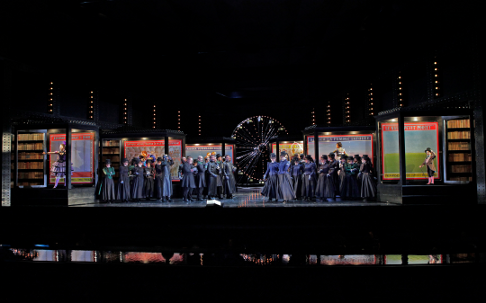 The Fair (Act II)
The Fair (Act II)
The splendid choral work, lots of it in this show, was directed by the hard- working and able Susanne Sheston. The mixed-period costume design was by Sue Wilmington, sometimes a puzzle but often quite attractive. Unusually effective lighting was well designed by Pat Collins, while the expertly directed choreography and actor movement was by Nocola Bowie with Lawless. The show as a whole was visually appealing, if at times the ideas behind it all were a bit obscure. If unremitting action counts for success, we saw success.
It would not surprise me if stage director Lawless and General Director Charles MacKay, whether they would admit it or not, were tempted to mount an all-out rather over-produced rendition of Gounod’s lyric classic in lieu of really memorable singing. How many in any given audience really know how Faust was sung in the so-called Golden Age of opera, and how difficult it is in the 21st Century to find a vocally ideal cast for an opera that was composed when Rossini and Meyerbeer were still alive? I cannot fault them, for theirs is the style of the time – the time of regieoper, to use the forbidding German term, when the intention of the stage director is often preferred to that of the original composer and librettist. At least Santa Fe’s first Faust was sung in the original French language (pace St. Louis); was at one level reasonably entertaining with comic moments; beautifully played by an expert orchestra and conductor, with a cast that was of average capability and produced no embarrassing moments. In such terms, the 2011 Faust was a huge improvement over the failings of Santa Fe’s curious 2010 Tales of Hoffman. More French repertory with Maitre Chaslin, s’il vous plait!
J. A. Van Sant © 2011
image=http://www.operatoday.com/FST2_1262a.png image_description=Ailyn Pérez as Marguerite and Bryan Hymel as Faust [Photo by Ken Howard courtesy of Santa Fe Opera] product=yes product_title=Charles Gounod: Faust product_by=Marguerite: Ailyn Perez: Marthe: Jamie Barton; Siebel: Jennifer Holloway; Faust: Bryan Hymel; Valentin (thru 8/1): Matthew Worth; Valentin (from 8/8): Christopher Magiera; Mephistopheles: Mark S. Doss' Wagner: Darik Knutsen. Conductor: Frédéric Chaslin. Director: Stephen Lawless. Scenic Designer: Benoit DuGardyn. Costume Designer: Susan Willmington. Lighting Designer: Pat Collins. Choreographer: Nicola Bowie. product_id=Above: Ailyn Pérez as Marguerite and Bryan Hymel as FaustAll photos by Ken Howard courtesy of Santa Fe Opera
July 8, 2011
Aix-en-Provence Festival 2011, France
By Francis Carlin [Financial Times, 8 July 2011]
The Aix-en-Provence Festival, far from falling off a cliff after the Berlin Philharmonic wound up its Ring cycle there in 2009, is still successfully playing the prestige card. The London Symphony Orchestra is now in residence, accompanying two operas this year and also giving concerts in the controversial indoor theatre that opened in 2007. That should make the building look less of a white elephant, though it is clear that the festival’s director, Bernard Foccroulle, considers the courtyard of the Archbishop’s Palace, where swallows squeal at the beginning of evening performances, as the emotional heart of the event.
July 7, 2011
The Marriage of Figaro, Opera Holland Park
Producer James Clutton took to the stage to announce that the original Susanna, Claire Meghnagi, had “left the production” and been replaced at short notice by Jane Harrington. In addition, Matthew Hargreaves, our elegantly attired factotum for the evening was not feeling on top form, but would soldier on regardless.
To paraphrase Lady Bracknell, “to lose one principal may be regarded as a misfortune; to lose two looks like carelessness”. In the event, if Hargreaves was suffering it did not affect him too greatly; there were a few problems with projection initially — he was rather tentative in the opening duets — but he quickly warmed up and by ‘Se Vuol Ballare’ was well into his stride (although conductor Matthew Willis nearly knocked him off-balance with some unexpected and inexplicable changes of tempo). If Hargreaves fudged a few of his notes at the top, it did not detract from a committed and lively performance. His camp, mincing, Jeeves-like antics were energetic and eye-catching, and he demonstrated a good sense of timing in what is an intricately choreographed production.
As for Harrington, she slipped effortlessly into the comic capers and complicated stage manoeuvres; she clearly knows this opera well, but if she really had had only a few days of rehearsal, she must have a remarkable stage memory. Her Susanna exuded brio, confidence and charm. Her Act 3 duet with the Countess ‘Sull’ aria’ was exquisitely sweet and clear. Indeed, the vocal expressivity of Elizabeth Llewellyn, as the disillusioned, disheartened Countess, was one of the highlights of the evening. Both ‘Porgi amor’ and ‘Dove sono’ powerfully conveyed her distress and established her aristocratic dignity. However, Llewellyn and her philandering Count, George von Bergen, (equally strong vocally, his dark registers booming out to suggest menace) are not the most convincing of actors and in a production that often found them at the front of the stage, statically facing the audience, they didn’t always make dramatic impact.
And, herein lies much of the problem with this production. For Liam Steel frequently neglects to direct the principals while involving the chorus in ceaseless hectic, and often distracting, activity. During the overture, the hustle and bustle of the upstairs/downstairs world was captured by a seething mass of servile retainers who rushed about the stage, plumping cushions, airing linen, carrying silverware (a debt, conscious or otherwise, to David McVicar’s ROH production?), and charging helter-skelter in and out of the numerous doors which extended in sharp perspective from the arched walls of Holland Park House (Emma Wee’s graceful set, cleverly calling the walls of the house into action). Such frenetic commotion on stage was not matched in the pit where, here and throughout the performance, rhythmic drive and forward momentum — so essential to the comic impetus — were sadly lacking. In general, Willis adopted an overly lyrical approach, eschewing the brisk crispness of the Classical idiom; occasional exaggerated dynamic contrasts and clumsy accelerations of pace could not inject the necessary joie de vivre.
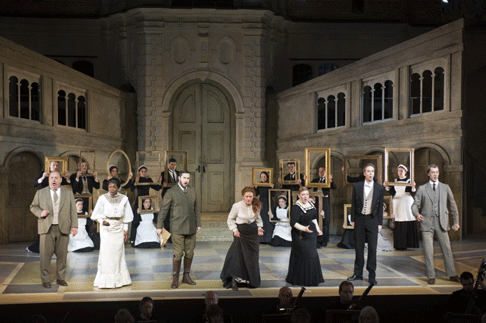 Scene from The Marriage of Figaro [Photo by Fritz Curzon]
Scene from The Marriage of Figaro [Photo by Fritz Curzon]
There were some deft theatrical touches — Cherubino’s leap through the chamber window into the geranium beds, for example, was neatly and wryly effected — but on the whole there was too much clutter and fussy choreography, which frequently hindered the singers’ attempts to establish character and dramatic situation through the music itself. Thus, Lynton Black struggled to convince us of Dr Bartolo’s vicious anger in the vengeful ‘La vendetta’, as the chorus farcically waved red books to and fro in the background; in case we were uncertain that Antonio (Henry Grant Kersell) is a gardener, his arrival in search of the destroyer of his precious flowerbeds was accompanied by a chorus of dancing geranium pots. When they weren’t parading picture frames or pirouetting around the furniture, the chorus were placing ‘legless’ furniture beneath the derrieres of their distressed masters and mistresses. The music was simply never allowed to speak for itself. Thus, even Cherubino’s gauche outpouring of adolescent passion, ‘Voi che sapete’, sung with bright clarity by a perky Hannah Pedley, was ‘illustrated’ by some mimed shenanigans by the four principals, subsequently imitated in a choreographed coda by a lower class quartet.
Although this chaotic stage business might have resembled a bedroom farce, the fact is that it simply wasn’t funny. The unpoetic banalities of the ‘re-written libretto’ (I hesitate to use the word ‘translation’) did not help; the surtitles not only lacked the grace of Da Ponte’s witty couplets, but frequently had only a tenuous relationship to the events and dialogue that the original libretto describes. Thus, despite some fine singing, hyperactivity on stage contrasted with lethargy in the pit, and as darkness fell, what is a long opera began to feel like a languorous one; one of the finest musical comedies reduced to dramatic inertia.
Claire Seymour
image=http://www.operatoday.com/Mozart_libretto_figaro_1786.gif image_description=Libretto of Le Nozze di Figaro, Prague 1786 [Image courtesy of Wikipedia] product=yes product_title=W. A. Mozart: The Marriage of Figaro product_by=Figaro: Matthew Hargreaves; Susanna: Jane Harrington; Count Almaviva: George von Bergen; Countess Almaviva: Elizabeth Llewellyn; Cherubino: Hannah Pedley; Dr Bartolo: Lynton Black; Marcellina: Sarah Pring; Don Basilio/Don Curzio: Andrew Glover; Antonio: Henry Grant Kerswell; Barbarina: Jaimee Marshall. Conductor: Matthew Willis. Director: Liam Steel. Designer: Emma Wee. Lighting Designer: Colin Grenfell. Opera Holland Park, Saturday 2nd July 2011. product_id=Above: Libretto of Le Nozze di Figaro, Prague 1786 [Image courtesy of Wikipedia]Scenes from Two Marriages
His nine titles sparsely revived so far since the 1910s, starting from Il Giuramento through La Vestale and Il Bravo to Caritea regina di Spagna and Elena da Feltre (to quote only the most successful), seemed to confirm that old judgment. Mercadante, a learned composer and a pious man who atypically devoted a large share of his output to both church and purely instrumental music, was hitherto construed as unfit for the comic.
Thus I due Figaro, whose original manuscript was recently unearthed in Madrid’s Biblioteca Histórica Municipal by the young Italian researcher Paolo Cascio, may appear a big surprise. It certainly was to Riccardo Muti who, on recalling his first reading of a few samples from the critical edition (later published by the same discoverer in collaboration with Víctor Sánchez Sánchez), declared: “I was unaware of [Mercadante’s] knack for comedy. Those pages came to me like a bolt from the blue.” To the Maestro’s credit goes the decision of presenting such an unknown score both at the Whitsun Festival in Salzburg and at his proprietary Ravenna Festival, if only for a short run of two nights each time. Next comes Madrid’s Teatro Real in 2012, but one may comfortably guess that many an opera house is already queuing for joining in. Our TV-oriented culture is so much dependent on prequels and sequels that success cannot lack.
The same was true also for early 19th century Madrid, not a provincial backwater at all, rather a flourishing colony of Italian opera outside Italy as much as it was during Farinelli’s tenure of the court theatres a century before. Mercadante, appointed as resident composer-cum-conductor at the Teatro del Príncipe, wrote there his I due Figaro, on a libretto by the starring poet Felice Romani previously set to music in 1820 by Rossini’s pupil Michele Carafa. The completed score was signed by Mercadante on October 26, 1826, but under the reactionary rule of Fernando VII the local censorship was unhappy with the representation of empowered women and gullible husbands, so the premiere was cancelled. It was only in 1833 that the opera crept its way on the Spanish stage, although the exact whereabouts are unknown; then an equally obscure revival took place in 1836, then nothing more.
To put it in a nutshell, the ‘scandalous’ story is about how, twelve years after Figaro’s marriage with Susanna, life goes on in Almaviva’s castle. In competition with Beaumarchais’ own nondescript sequel as La mère coupable (1791), the actor Honoré-Antoine Richaud Martelly produced in 1795 his Les deux Figaros, where Cherubino, now a colonel in the Spanish army, is in love with Inez, the daughter of Count and Countess Almaviva. Figaro number one entices the Count into having the girl married with Torribio, a servant disguised as a nobleman, in order that both accomplices can share her dowry fifty-fifty. Yet Susanna, Inez and the Countess finally defeat their home tyrants as Cherubino, entering the Count’s service as a self-styled Figaro number two, outwits the original with a salvo of tricks and succeeds in exposing his schemes. Inez and Cherubino are allowed to marry, while Figaro barely escapes being fired.
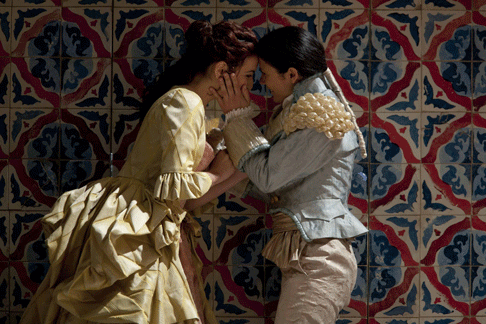 Rosa Feola as Inez and Annalisa Stroppa as Cherubino [Photo by Silvia Lelli]
Rosa Feola as Inez and Annalisa Stroppa as Cherubino [Photo by Silvia Lelli]
Despite a necessary suspension of disbelief, the French comedy (and the Italian libretto derived from it) is less a farce than a semi-serious drama, a study in characters where psychological depth is not missing. Both veteran couples, the masters and the servants, seem worn-out and complain about the ephemeral nature of romance; moreover, the Countess is aware that Almaviva is still attracted by Susanna, so that the general reconciliation in the finale seems highly perfunctory. Is there such a thing as a happy marriage in the long run, and will the brand-new couple escape what seems a general fate? A further sequel was perhaps in sight, but none has written it so far.
Mercadante’s music adheres to the subject matter with admirable cleverness, if not with a particularly idiomatic style. One tastes now and then Mozart’s subtle characterization of both vocal and instrumental color, but more often the model is provided by Rossini, up to quotations or paraphrases of individual themes. Intoxicating accelerandos and crescendos in the large-scale multisectional ensembles were rather commonplace at that time, as were extended cantabile arches or abrupt dramatic twists in the harmony. Summoning such names as (again) Rossini, or Bellini, or Donizetti would seem unnecessary, were it not to avow that in most instances Mercadante can well stand up to the paragon.
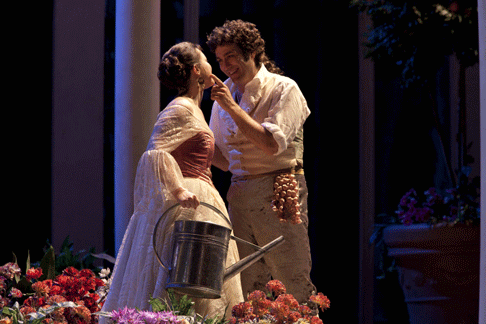 Eleonora Buratto as Susanna and Mario Cassi as Figaro [Photo by Silvia Lelli]
Eleonora Buratto as Susanna and Mario Cassi as Figaro [Photo by Silvia Lelli]
Everything as expected, except for a decided vein of local color: not only the fandango once so dear to Mozart, but a regular orgy of rhythms and forms from Andalusia (after all, the action takes place in the castle of Aguas Frescas near Seville). Bolero, cachucha, polo and tirana keep infiltrating over and over the principals’ cavatinas and even the overture, while the large Italian-style arias, studded with virtuosic coloratura, demand vocalist with considerable natural gifts, technical skills, and style awareness.
Eleonora Buratto, whom I recently heard in Modena as a model Cleopatra in Handel’s Giulio Cesare, towered here in the role of Susanna, with all the remaining ladies accompanying her in triumphal procession: witty Asude Karayavuz as the Countess, mellow Rosa Feola as Inez, and Annalisa Stroppa as a Cherubino already eligible for the toughest Colbran roles. Among the gentlemen, duels of both physical and vocal energy between Mario Cassi as Figaro number one and Omar Montanari as Plagio, the playwright in distress much in the mould of Prosdocimo in Rossini’s (and Romani’s) Il Turco in Italia. Passion and melancholy in store from the high tenor Antonio Poli as Almaviva; Anicio Zorzi Giustiniani, a promising Baroque specialist, seemed underutilized in the cameo role of Torribio. Incredible but true: within such a brilliant company, hand-picked by Riccardo Muti, none exceeds the age of thirty; the same is more or less true for the youth orchestra “Luigi Cherubini”, another brainchild of Muti’s.
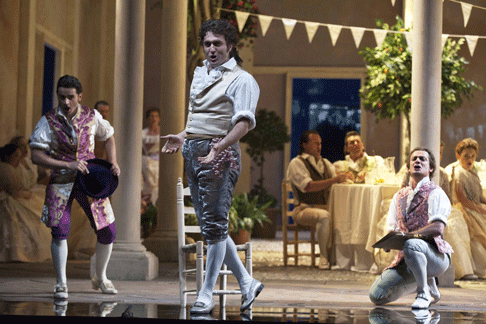 Anicio Zorzi Giustiniani as Torribio, Mario
Cassi as Figaro and Omar Montanari as Plagio [Photo by Silvia Lelli]
Anicio Zorzi Giustiniani as Torribio, Mario
Cassi as Figaro and Omar Montanari as Plagio [Photo by Silvia Lelli]
Emilio Sagi’s stage direction kept the action revolving within and around a patio decorated with eight columns in white plaster and lots of flowers. Everything, including costumes, as Spanish, rural and historically informed as one could wish. To be sure, Ravenna Festival is not the proper place for Eurotrash. The audience, having to face a complex plot without any subtitles to help them, seemed to appreciate, but the loudest applause was as usual for the local darling Muti, the man who is bringing Ravenna back on the international map of opera.
Carlo Vitali
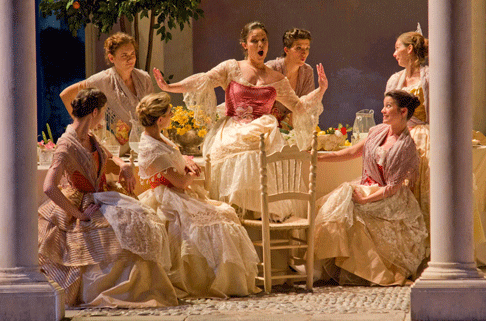 Eleonora Buratto as Susanna and country lasses [Photo by Maurizio Montanari]
Eleonora Buratto as Susanna and country lasses [Photo by Maurizio Montanari]
July 6, 2011
Juan, a film by Kaspar Holten
It is indeed an English adaptation, presented here in the US with English subtitles, updated to a modern European city (filmed in Denmark and Hungary). “Juan” lives in a loft, from which he carries on ‘The Woman project’, which is essentially his effort to seduce a zillion women, with his Russian sidekick “Lep” taking clandestine video and stills of the assignations (his famous Catalogue Aria is sung to Elvira with a Macintosh laptop in his hands, the folders of which contain the visual records of the seductions). The film opens at a performance of “Don Giovanni”, where Ottavio introduces Anna to his friend Juan, and the vibes between them lead her to part from her police chief father and fiancé Ottavio after the performance in order to meet Juan in a café. We see a tryst at her house, which is interrupted by the return of the father, who goes after Juan with a gun, which goes off in the struggle, mortally wounding him. The Anna-Ottavio duet is sung as they load the father into the ambulance and ride to the hospital. This is the first of many instances in which characters’ motivations, which are left ambiguous in the opera, are clearly spelt out (people like to argue about whether Anna has been seduced or raped—in our day people assume the former, given the nature of the Don Giovanni archetype, but the 19th century saw it differently).
Lovers of the opera will be disappointed at the many musical cuts. In the first act, I counted the following omitted arias: Masetto’s “Ho, capito”, Elvira’s “Fuggi il traditor”, Anna’s “Or sai chi l’onore” (although the recit is left in, with flashbacks to a passionate lovemaking with Juan all the while she’s telling this story of a rape to the police), Ottavio’s “Dalla sua pace” (also “Il mio Tesoro” in the second act—he essentially sings the two ensembles in the first act and some recitative) . In the second act there are more cuts—none of the scene between Leporello and Elvira, none of the ensemble in which the characters confront Leporello, nothing of the beating of Masetto (and Zerlina’s “Vedrai carino” is cut). Interestingly, and somewhat annoyingly to me as a woman, it’s always very clear that the three women are completely under Juan’s spell: “La ci darem” takes place in a cab going back to Juan’s loft, and continues in the loft as they take their clothes off and start to have sex, only interrupted by the fact that Elvira has gotten there first; Anna’s retelling of her meeting with Juan speaks to the masculine fear of a woman crying rape after sex that he considered to be consensual; Elvira is as obsessed with him as she is in the opera, becoming a tragic rather than comic character as she drowns herself after singing about half of “Mi tradi”. On the other hand, both Ottavio and Masetto walk when they find out they’ve been deceived by the women: Masetto is clearly sexually drawn to Zerlina while she sings “Batti batti, but he keeps turning away from her, and says “It’s over” to her at the end of it; Ottavio takes Anna’s returned engagement ring and walks out between the recitative and aria sections of “Non mi dir”. It’s not pleasant to see the men portrayed as somehow stronger than the women when it comes to resisting the temptation to be drawn by sex into something that’s going to hurt them. I suppose the director’s argument would be that no human woman has the sexual power that the larger-than-life masculine force of Don Giovanni has.
The supernatural elements are essentially removed: instead of a stone statue coming to life, there is a shadowy hooded figure that Juan keeps seeing at crucial points when he’s behaving exceptionally badly (the killing of Anna’s father, the party at his loft where the first act finale takes place, etc.). There is a sequence where Juan and Lep encounter a street shrine with a photo of the dead police chief—Juan is seeing the shadow figure while he’s making Lep invite the police chief’s picture to dinner. The final trio takes place in a hijacked car in a high speed chase by the police, with an encounter in Juan’s mind between himself and this shadowy figure (who is singing the Commendatore’s part)—the figure turning out to be Juan himself. Needless to say, there’s no final envoi with the characters coming out to say what will happen to them next (The two other couples have broken up, and Elvira’s dead).
The overall rather grainy look of the movie includes many visual statements about what’s going on. The consensus of the people who saw the film with me is that it works well as a movie; captures the “Don Juan” archetype and its impact very well. I would not say that it’s a particularly good introduction to the opera; too many cuts, essentially the director using the opera to tell the story, rather than Mozart doing it through the music. Recitatives are partly sung, partly spoken, and carry much more of the drama than they would in the opera. Maltman acts well and sings well enough (One person heard some intonation problems, but I felt he acquitted himself well, and he certainly looks the part: he is most naked singing “Fin ch’ha dal vino” in the shower, although the sex scenes are quite explicit. There are many closeups of his frequently unshaven face. Elizabeth Futral as Elvira did a nice job with the arias that were left to her (the opening one, which is interrupted by Don Giovanni, and the duet in which he convinces her to go to an assignation elsewhere—in the opera she unknowingly has this tryst with Leporello, in the movie no one ever shows up, leading her to sing the recitative and part of “Mi trade” as she walks down into the river). Mikhail Petrenko as “Lep” was fine, both acting and singing; in some ways I think his character was the most successful and amusing of the updates. Maria Bengtsson as Anna acted well (as did everyone) but her performance of the fiendishly difficult “Non mi dir” didn’t do the music justice, I think. Peter Lodahl as Ottavio and Ludwig Bengtson Lindström as Masetto acted well but didn’t really have enough to sing to judge. Katijya Dragojevic as Zerlina got more to sing than they did, and she did her music justice—it was also absolutely clear that Juan was not seducing a virgin here.
Barbara Miller
image=http://www.operatoday.com/Juan_Holten.gif image_description=Juan, a film by Kaspar Holten [Photo courtesy of official web site] product=yes product_title=Juan, a film by Kaspar Holten product_by=By Barbara Miller product_id=Above: Juan, a film by Kaspar Holten [Photo courtesy of official web site]Cendrillon, Royal Opera House, London
By Richard Fairman [Financial Times, 6 July 2011]
One wave of the fairy godmother’s magic wand and Massenet’s delicate opera might disappear. Its music alternates between long scenes of comic business as threadbare in material as Cinderella’s rags and light-as-thistledown love duets as enchanting as any ever written. Long neglected, Cendrillon is getting its first performances at the Royal Opera House.
Der Ring des Nibelungen in San Francisco
The final curtain down at last on the second cycle, the audience leapt to its feet and roared. What was all the fuss about?
The delights of the San Francisco Ring were myriad. The cycle played out over a mere six days during which Wagner’s drama did not seem to stop. It was an immersion Ring rather than episodic one as the Freyer Ring in L.A. seemed over its ten long days, not to mention the Berlin Philharmonic Ring in Aix-en-Provence that was spread over four years.
Conductor Donald Runnicles slid into the initial E flat pedal tone and relentlessly sustained Wagner’s orchestral deliberation for its seventeen hour duration. The maestro drove an orchestral continuum that was imperceptibly fleet (it was actually fast), its speed though was calibrated to the careful articulation of Wagner’s score, the conductor knowing that Wotan’s plight and designs give rise to riveting music only when they are musically exploited to the maximum.
Mo. Runnicles achieved a rare transparency of orchestral sound in the War Memorial, the percolating inner voices of the continuum often shining brilliantly in the vast space of the hall as they can never do in the recordings we use to learn and casually listen to the Ring. And too the vast spaces of the War Memorial allowed huge fortes to roll forth, immersing the hall in mighty sound, Even the quirks of the hall contributed, its “golden horseshoe” overhang magnifying the eight horns and double timpani for those of us seated on the right side of the orchestra.
The careful musical exposition was subject to the largest arc of Wagner’s myth, the orchestral climax of the entire Ring occurring about sixteen hours into it, only at the end of the second act of Götterdämmerung when Mo. Runnicles unleashed it all for Brünnhilde’s pact with Hagen to murder Siegfried. This Ring was bigger than its pieces, and we understood that the usual frenzy we missed at the conception of Siegfried was measured against the hugely complex dilemma of his death.
It is futile to discuss the concept of the production, San Francisco Opera touting it as “an American Ring.” There were indeed vibrant American images, like redwood trees. like American industrial wastelands, but the Gibichung headquarters was well beyond the 1930’s American skyscrapers director Francesca Zambello cites in her program book apology, and much more on the scale of Austrian expressionist Fritz Lang’s immense Metropolis of his 1927 film. And too the light green behind Brünnhilde’s fire seemed more like a weird color choice that an evocation of escaping industrial gases.
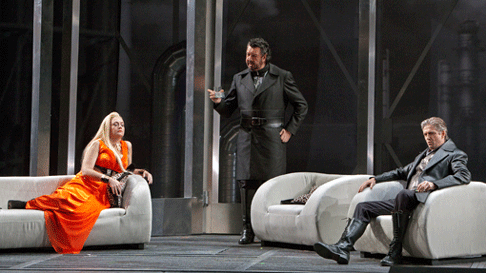 Melissa Citro (Gutrune), Andrea Silvestrelli (Hagen) and Gerd Grochowski (Gunter)
Melissa Citro (Gutrune), Andrea Silvestrelli (Hagen) and Gerd Grochowski (Gunter)
All these specific images however quietly dissolved into the careful storytelling that was the hallmark of the Zambello production. Not a musical motive was left without a corresponding movement on the stage, no musical interludes were left on an abstract imaginative level but accompanied by moving projections — clouds, water, trains, fire, more clouds, etc. It was a fully illustrated Ring (take it or leave it) that (if you took it, and that took a while) eased you, even gracefully, inside the Ring’s musical universe.
It was an easy, engaging Ring that deflated Wagnerian philosophical pomposity at every turn with surprising, sometimes funny twists — Alberich attached to his homeless supermarket cart searched for Faftner with infrared binoculars, the forlorn Rhine maidens hopelessly picked up plastic bottles from a dried up river bed, beer guzzling buddies who were actually sworn enemies downed cases. Not to mention the purely comic book, utterly delightful visuals for Fafner and Fasolt, or the Valkyries parachuting onto the rocks of Valhalla (this image said to have been borrowed from a Swedish commercial for a detergent powder).
Finally the Zambello Ring maybe even arrived at tongue-in-cheek with the black covered Arab-esque women cowering in the wake of their men, black uniformed fascistic soldiers of Hagen’s evil army. Not to intimate that Mme. Zambello did not somehow make all this bring Wagner alive. She did.
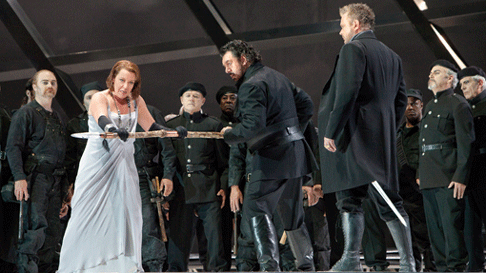 Nina Stemme (Brünnhilde), Andrea Silvestrelli (Hagen), Ian Storey (Siegfried) and Ensemble
Nina Stemme (Brünnhilde), Andrea Silvestrelli (Hagen), Ian Storey (Siegfried) and Ensemble
San Francisco Opera promoted a number of seminars to accompany its Ring, Anti-Semitism was a big topic, though it was put in succinct perspective by the Mime of the production, David Cangelosi who rhetorically asked “haven’t we turned the page on all that?” Distinguished lecturers examined the Ring in Schopenhauerian terms, a former Buddhist monk delineated the Ring’s roots in Buddhism. The most convincing of the philosophical analogies described the Ring in purely Sartrean Existential terms. (I might also mention a concert of Wagner transcriptions on the 5000-pipe organ of St. Mary’s Cathedral — the Ride of the Valkyries executed by four hands and four feet and those 5000 pipes).
Well, none of that for the San Francisco Ring. While there were two real dogs portraying wolves, a bear played by a real man and a number of fantastic and dead animals involved, there was no horse at all for Brunnhilde to ride into the flames. The flames were fed by the downtrodden Gibichung women and the Rhine maidens throwing the plastic bottles picked up from the riverbed (tossed there by males in the context of this production). Gutrune, a male-victimized “moll” embraced Brünnhilde and we understood that she was redeemed. Photographs of the fallen heros rescued by the Valkyries showered down and at last a young girl planted a tree. Mo. Runnicles had had his fun with the murder pact, the usually spectacular ending instead was musically rather resigned.
This was not a minimal Ring created by veteran opera designer Michael Yeargan. There were four superimposed prosceniums and a sentient floor (lighted from underneath) that served as the stage mechanism for the Wagner mega-drama, with full stage screens flying in and out at all depths of the stage to capture the inexhaustible catalogue of projections developed by Jan Hartley and her associates. If the freeway interchange under which Wotan saw Siegmund die and where he murdered Hunding was not life size it seemed so. Hunding’s mountain cabin was as good as real as was Mime’s wrecked Airstream trailer.
What, you may ask, held all this together. It was the Brünnhilde of Swedish soprano Nina Stimme who brought bonafide Teutonic style to rock solid vocal production and muscular physicality to her indefatigably energetic Valkyrie. This Ring was Brünnhilde’s personal story, placed in even higher relief by the pallid portrayal of Wotan by American bass Mark Delavan, a performance that effaced the Wagnerian complexities and emotional stature of this human father cum transcendent being. The suspicion lurks that this was the intention of Zambello, a suspicion founded on the portrayal of Siegfried as one step above the village idiot, charmingly rendered by Jay Hunter Morris in Siegfried, and less vividly but vocally far more convincing by English tenor Ian Storey in Götterdämmerung.
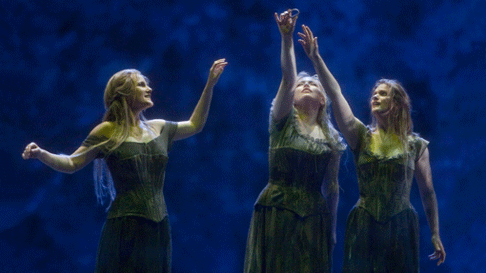 Lauren McNeese, Renée Tatum and Stacey Tappan (The Rhinemaidens).
Lauren McNeese, Renée Tatum and Stacey Tappan (The Rhinemaidens).
There were several performances that stood out among the universally good performances of the entire cast. The Siegmund of American tenor Brandon Jovanovich was disarmingly charismatic and Italian basso Andrea Silvestrelli created Zambello’s arch villain Hagen with supreme testosterone gusto. American tenor David Cangelosi as Zambello’s creepy hobo Mime succeeded in making the first two acts of Siegfried high points (well, among many) of the entire cycle.
San Francisco Opera does not seem to have been a competitor in who-can-spend-the-most-for-a-Ring contest. Still, there went a pile of gold. One assumes costumer Catherine Zuber was well rewarded for what was an heroic and immensely successful effort, as was the complex lighting of Mark McCullough — both seasoned opera pros, like Zambello and Yeargan and their supporting teams.
It was not a prestigious Ring, like the Aix Ring with the Berlin Philharmonic in the pit (by the way with the six harps Wagner requires — San Francisco made do with two) with its elegant, minimalist staging by Stéphane Braunschweig. It was not an arty Ring imagined in a rarefied visual language like the splendid L.A. Achim Freyer Ring, nor was it a big, international house Ring with proven big name interpreters and the flavor-of-the-day producer (by the way that would be the Robert Lepage Ring at the Met).
The San Francisco Ring was a good Ring, if a wacky one that seemed at times like it might even be a spoof. It was however, perhaps therefore absolutely understandable. The experts may debate how it betrayed or illuminated Wagner’s musico-philosophic treatise, but they too will admit that those seventeen hours in the War Memorial Opera House were full of fun and richly rewarding.
Michael Milenski
image=http://www.operatoday.com/Gott-DR-1.gif image_description=Nina Stemme (Brünnhilde) and Ian Storey (Siegfried). [Photo by Cory Weaver courtesy of San Francisco Opera] product=yes product_title=Richard Wagner: Götterdämmerung product_by=Click here for cast and other information. product_id=Above: Nina Stemme (Brünnhilde) and Ian Storey (Siegfried).All photos by Cory Weaver courtesy of San Francisco Opera
July 4, 2011
Did Tosca survive?
By Alex Ross [The Rest is Noise, 4 July 2011]
On my jazz-beflecked visit to the Castel Sant'Angelo, I had a thought that surely has occurred to countless Puccini-minded tourists before me: where did Tosca jump from exactly?
July 2, 2011
Soprano regains her composer
By Joyce Morgan [Sydney Morning Herald, 2 July 2011]
With her mane of wavy hair, the woman swaying along to the Cure at the Opera House recently may have looked familiar. But soprano Cheryl Barker is more often seen on its stage than in the audience.
July 1, 2011
Kat’a Kabanová in the big city
By Zerbinetta [Likely Impossibilities, 1 July 2011]
The Wiener Staatsoper’s season closed last night, and I finally got to see the new production of Janáček’s Kat’a Kabanová, conducted by music director Franz Welser-Möst and directed by André Engel.
The Puzzle Of Rossini’s Brief Career
By Zachary Woolfe [NY Times, 1 July 2011]
There are lots of theories. Maybe Gioachino Rossini was tired. He might have been devastated by the death of his beloved mother.